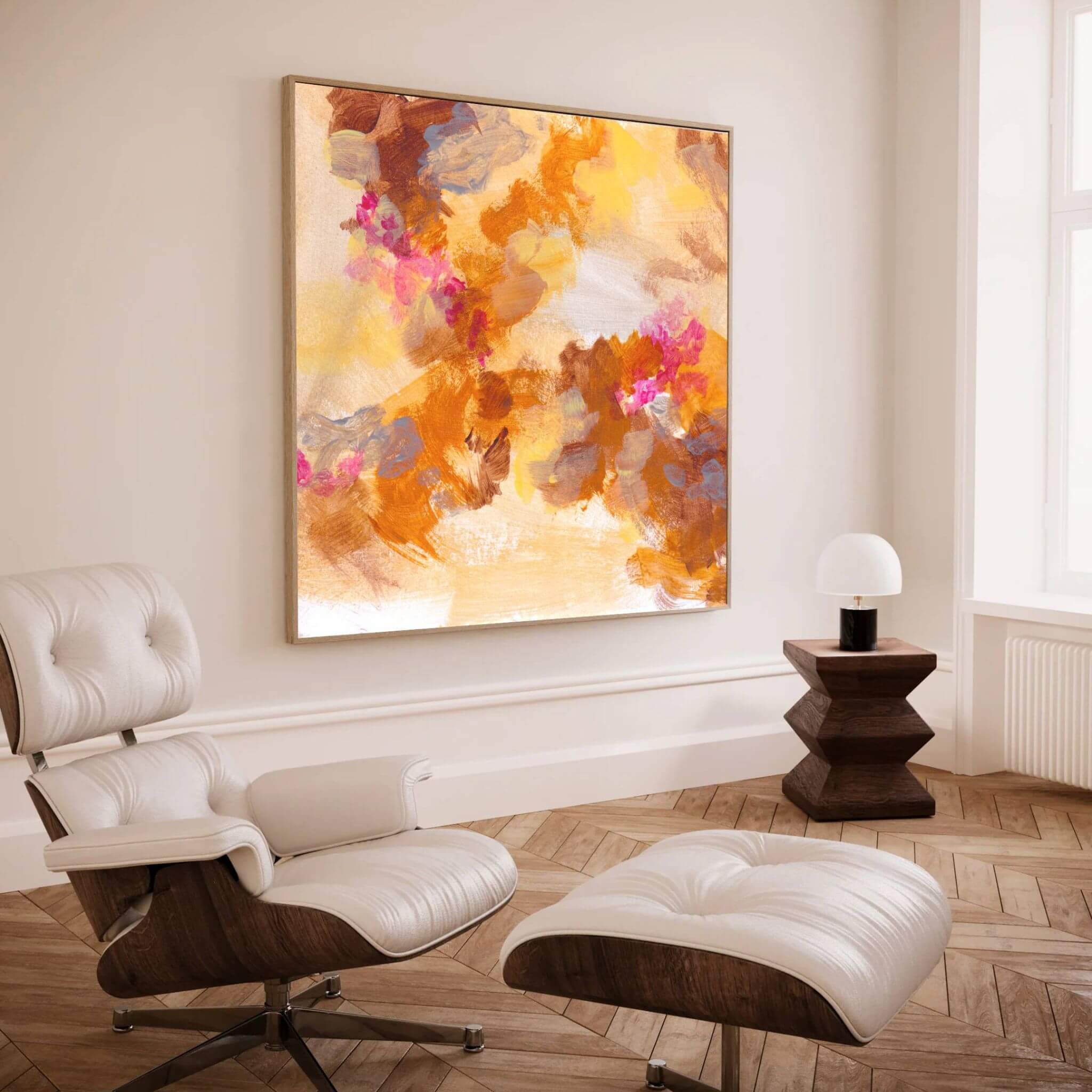Art for Mindful Office Spaces: The ROI of Emotionally Intelligent Design
There’s a quiet revolution unfolding inside high-end offices around the world. It’s not loud. It’s not branded. It’s not being driven by interior design fads or corporate motivational posters.
It’s happening through colour, through stillness, through presence. It’s happening through emotionally intelligent art.
In this age of always-on culture and cognitive overload, emotionally intelligent design is becoming non-negotiable. The spaces we spend our working lives in are finally being recognised not just as places of productivity, but as environments that shape how we feel, think, lead, and live.
And at the heart of this evolution? Art. But not the kind that decorates. The kind that restores.
This is not about visual identity. It’s about emotional capacity.
In the past, high-end offices invested in art for prestige or branding. Now, forward-thinking firms are investing in art as a cognitive asset, something that doesn’t just fill space, but alters how space is experienced. Something that helps the nervous system reset between decisions, that invites presence in high-pressure environments, that becomes part of a silent ecosystem of performance, trust, and wellbeing.
This isn’t theory. It’s measurable. It’s trackable. And it’s deeply felt by everyone who walks through the door.
Throughout this guide, we’ll explore what emotionally intelligent art actually is, how it supports mindful office design, and why the best firms in the world are making it part of their strategic ecosystem, not an afterthought. You’ll learn what to look for, what to avoid, and how to integrate art into your workspace in a way that elevates clarity, reduces friction, and cultivates a work culture where emotional intelligence isn’t just talked about, it’s felt.
Whether you’re curating a founder’s office, redesigning a leadership floor, or rethinking the emotional tone of your client spaces, this guide will show you exactly why art for mindful office spaces is not only desirable, but essential.
Let’s begin with the core question.
What Is Emotionally Intelligent Art?
Most people think they know what art is. They think of framed landscapes, dramatic abstracts, or provocative installations in museum settings. But emotionally intelligent art lives in a different category entirely.
It’s not there to decorate. It’s not there to signal wealth. It’s not even there to spark conversation.
Emotionally intelligent art is there to hold space.
It doesn’t dictate. It responds.
Unlike decorative pieces that dominate a room with bold themes or literal imagery, emotionally intelligent art is subtle but not forgettable. It is felt more than it is noticed. It sits within a room like breath sits within the body: quiet, essential, foundational.
It provides a moment of anchoring in environments that often pull people away from themselves.
In emotionally complex workspaces, think legal offices, therapy practices, investment firms, strategic consultancies, people are constantly managing their emotional bandwidth. They’re absorbing client stress, navigating interpersonal dynamics, juggling strategic complexity. In spaces like these, emotionally intelligent art becomes a grounding element, something that restores nervous system coherence without demanding attention.
It creates psychological permission
Have you ever walked into a space and instantly felt more calm, more clear, more able to think?
Chances are, that space included elements that granted your nervous system permission to slow down. Soft lighting. Quiet surfaces. And, often, emotionally intelligent art.
These artworks create subtle somatic cues that say, “You’re allowed to breathe here.”
That permission is especially vital in workspaces that prioritise high performance. If you want clarity, the nervous system must first feel safe. Emotionally intelligent art helps signal that safety, not by depicting it, but by embodying it.
It resists oversimplification
Most corporate art is chosen for clarity: it should match the brand palette, reflect the company’s mission, and be “clean” enough not to offend.
But the best emotionally intelligent art resists clarity in the traditional sense.
Instead of being a visual explanation, it becomes a visual invitation, something ambiguous enough to reflect back multiple emotions, multiple states of mind, multiple layers of experience.
In a well-designed office, this matters. Because your team, and your clients, are never static. They arrive with different moods, different stories, different nervous systems. One day they’ll see strength in a piece. The next, they’ll see softness. That’s the point.
This isn’t passive decoration. It’s active emotional intelligence, rendered in form and colour.
It’s not about “art appreciation”
One of the biggest misconceptions in workspace design is that art should be “understood.”
Emotionally intelligent art doesn’t need to be understood. It needs to be felt.
You’re not commissioning a thesis. You’re not hanging something so your staff can discuss it over coffee. You’re placing something in the room that helps regulate the emotional climate, something that becomes a silent co-regulator for everyone in the space.
This is why emotionally intelligent art often works best when it’s abstract, layered, and emotionally spacious.
It’s not trying to be clever. It’s trying to be true.
Summary
Emotionally intelligent art is not a category you find in a catalogue. It’s a felt quality, an intentional approach, and a strategic tool for emotional regulation and presence.
In high-end offices, that intention carries weight. Because when your space feels more grounded, your people perform better. When your walls hold emotional presence, your clients trust you faster. And when your art meets your team where they are, without forcing them to feel something specific, you build emotional culture without ever needing a single slogan.
This is what makes emotionally intelligent art a cornerstone of mindful office design.
In the next section, we’ll explore why these kinds of offices are becoming the new standard, and why firms that ignore this shift are falling behind.
Why Mindful Office Spaces Are the New Standard
Let’s be blunt. The traditional office is dying.
And it’s not because of hybrid schedules or post-pandemic real estate shifts. It’s because the people inside the office, the ones doing the actual work, are demanding better.
Not louder. Not trendier. Not more caffeinated.
Better.
They want spaces where they can focus without friction. Spaces where their nervous system isn’t constantly being hijacked. Spaces where they can make high-stakes decisions without feeling like they’re drowning in cortisol. And spaces where their emotions are not liabilities, but assets.
That’s where the mindful office enters.
Defining the mindful office
A mindful office is not a yoga studio in disguise. It’s not about adding incense and a wall decal that says “breathe.”
It’s about designing spaces that support presence. That reduce unnecessary noise, visual, auditory, emotional. That prioritise how people feel, not just how they perform.
And that includes the art on the walls.
The psychology behind mindful workspaces
Studies across workplace psychology, cognitive neuroscience, and human factors design have shown that our environment directly shapes:
-
- Attention span
- Emotional regulation
- Task switching capacity
- Decision fatigue
- Empathy and collaboration
- Long-term memory retention
This isn’t a matter of preference. It’s biology.
When your space is overstimulating, your staff underperform. When your environment feels chaotic, your ideas get fuzzy. When your visual surroundings constantly push for attention, your emotional resources are drained, fast.
That’s why design elements that support mindfulness, including lighting, layout, noise levels, materials, and artwork, are no longer nice-to-haves. They’re essentials.
And the smartest firms know it.
From stimulus to sanctuary
Most modern workspaces are full of micro-stressors:
-
- LED light flicker
- Poor acoustics
- Unnatural materials
Overloaded visual stimuli (logos, posters, digital screens)
These add up. By the time someone sits at their desk, they’ve already burned through part of their cognitive fuel, and they haven’t even opened their inbox yet.
A mindful office does the opposite. It strips back everything unnecessary. It simplifies. It calms. And through emotionally intelligent art, it offers visual pathways back to presence.
Think of it like designing a mental sanctuary, not to escape from work, but to do it better.
Why it’s now a competitive advantage
The firms that adopt emotionally intelligent design aren’t just doing it for aesthetic points. They’re doing it because they want to:
-
- Attract better clients (who are emotionally intelligent themselves)
- Retain better talent (who won’t tolerate overstimulating spaces)
- Reduce hidden costs (stress, burnout, decision fatigue)
- Signal values alignment (wellbeing, presence, emotional maturity)
The mindful office is not a cost. It’s a conversion tool, a leadership asset, and a retention strategy.
Where art fits in
In the architecture of mindfulness, art is not the garnish. It’s one of the pillars.
Because no matter how well you design the flow of a space, the surfaces people see all day, the walls they glance at between meetings, the views from their desk, those visuals shape their nervous system.
And when you place emotionally intelligent art in those line-of-sight moments, you’re doing more than decorating. You’re influencing how people return to themselves, again and again, in the middle of a busy day.
In the next section, we’ll dig into the science and psychology that explain why art, specifically emotionally intelligent art, has such a powerful impact on emotion, cognition, and performance.

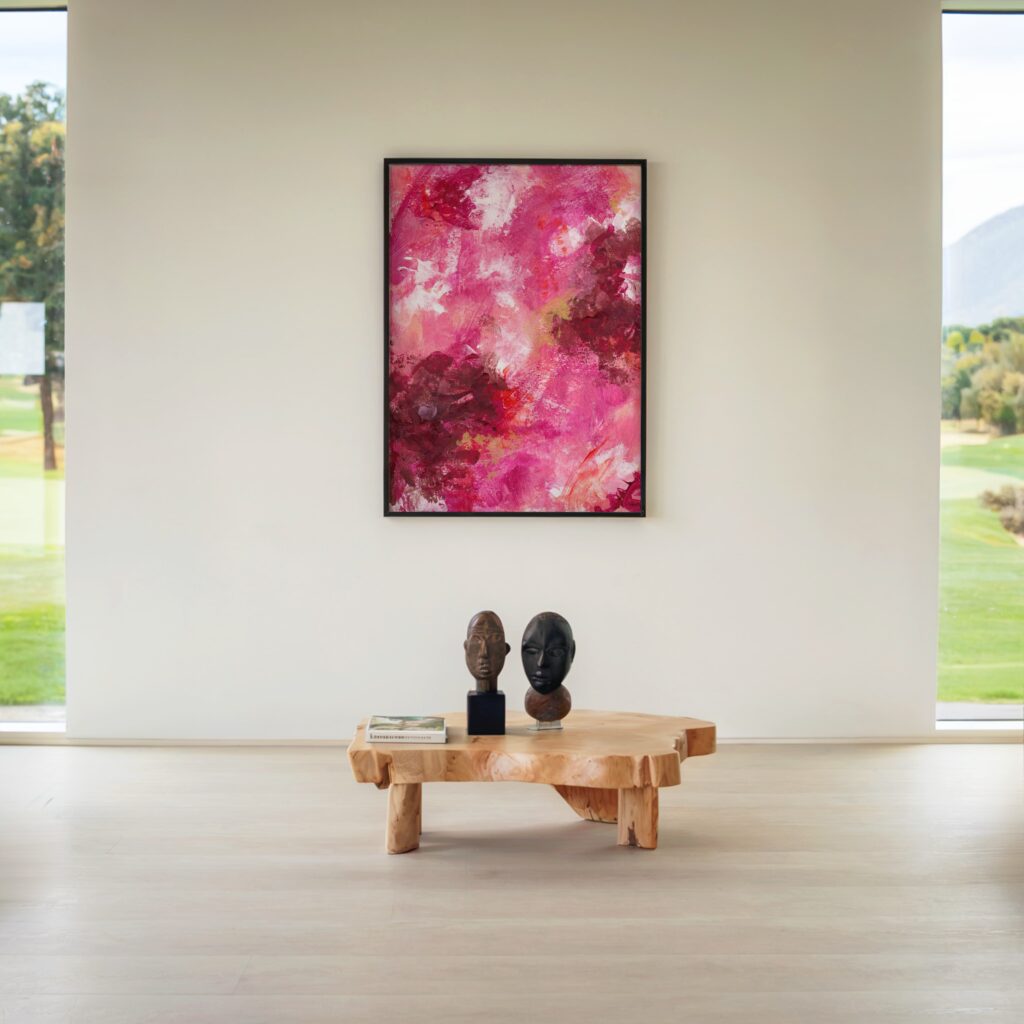
The Link Between Emotion, Art, and Workplace Performance
If you want better performance from your team, it starts with one invisible factor: how they feel.
Not how they look on paper. Not how they speak in meetings. But how they actually feel in the space, in their bodies, in their minds, in their work.
This is not emotional fluff. It’s the foundation of sustained, strategic output. And emotionally intelligent art is one of the few design elements that can influence that foundation directly, immediately, and wordlessly.
Here’s how.
Emotions are not background noise. They’re operating systems.
Everything we do in the workplace, whether it’s ideation, decision-making, conflict resolution, client negotiation, or leadership, is filtered through emotion.
Not in a vague, touchy-feely way. In a practical, brain-based way.
When a person walks into a room and their nervous system feels threatened, overloaded, or disoriented, their access to executive functioning drops. Their ability to innovate, self-regulate, or make nuanced decisions narrows. Even their ability to perceive tone or read body language becomes less accurate.
But when a space supports emotional regulation, visually, energetically, and spatially, the opposite happens. People expand. They listen better. They lead better. They create better.
And art plays a massive role in that process.
Art shapes the invisible
In a workspace, emotion is often suppressed. Everything is about outcome. Target. Agenda. Progress.
But the undercurrent? That’s all emotional. And when it’s ignored, it leaks out in all the wrong ways, conflict, miscommunication, decision fatigue, mental absence.
Emotionally intelligent art doesn’t fix that. But it supports the conditions that make emotional presence possible.
For example:
-
- A layered abstract piece in a high-conflict boardroom creates pause before reaction.
- A spacious, expansive composition in a CEO’s office can reduce adrenaline spikes after back-to-back meetings.
- A warm-toned, textured canvas in a coaching space signals psychological safety before a single word is said.
This isn’t hypothetical. These are real-world effects, felt viscerally and instantly.
Art alters physiology, not just mood
Multiple studies have shown that visual stimuli impact heart rate, blood pressure, and even immune system function.
When someone experiences artwork that feels calming, expansive, or grounding, the parasympathetic nervous system is activated. That means digestion improves. Cognitive load decreases. Emotional regulation stabilises.
In a mindful office environment, this has enormous consequences:
-
- Meetings become more focused and less reactive
- Conflict is de-escalated before it ignites
- Complex projects feel more manageable
- The physical body feels more at ease during long workdays
In short: people stop working from survival. They start working from clarity.
What “emotionally intelligent” looks like in practice
Emotionally intelligent art in workspaces is rarely flashy.
You won’t find it screaming from the walls in primary colours or hiding corporate slogans in abstract shapes. You’ll find it sitting quietly, intentionally, in spaces where emotional labour is high and visual grounding is necessary.
Look for pieces that:
-
- Offer visual rhythm without being busy
- Use colour palettes that match the emotional tone of the space
- Feel present without demanding interpretation
- Offer a sense of spatial or emotional “breath”
If your art feels like it’s holding space rather than filling it, you’re on the right track.
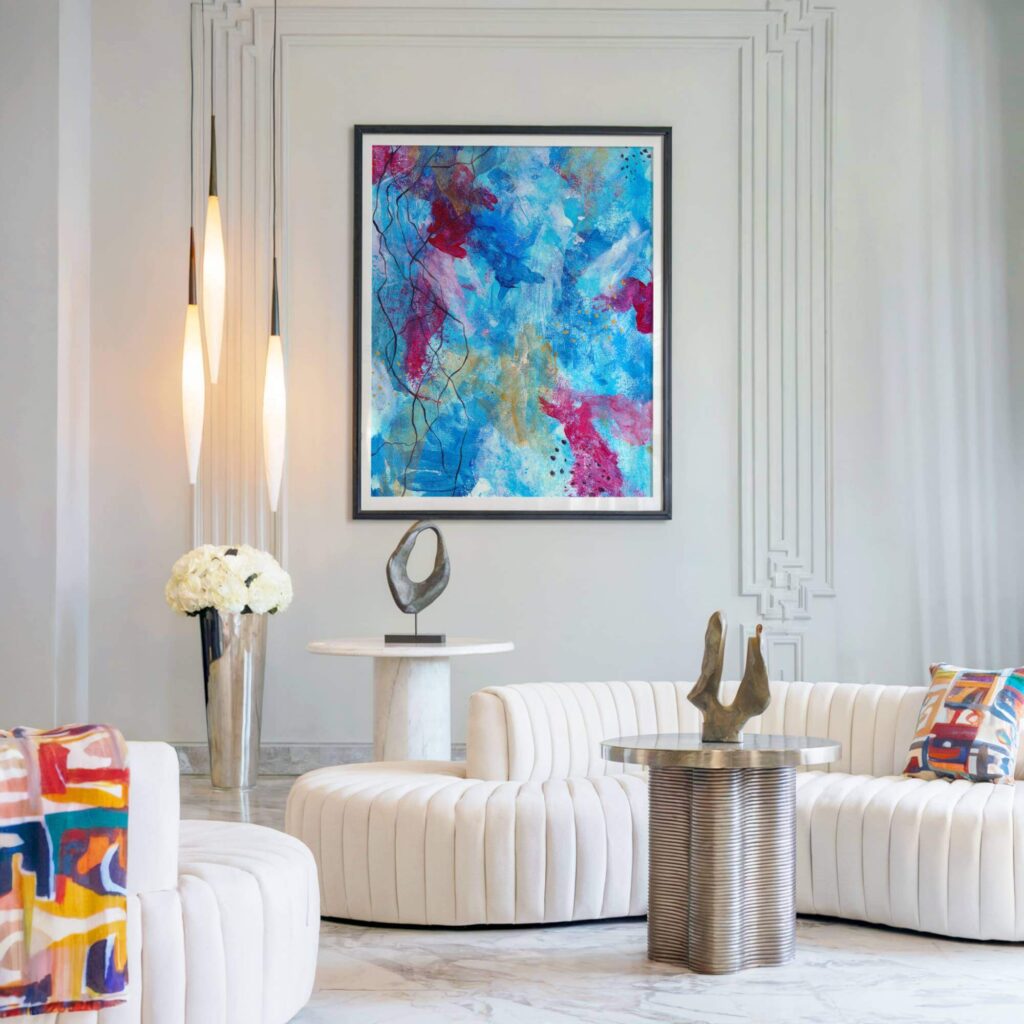
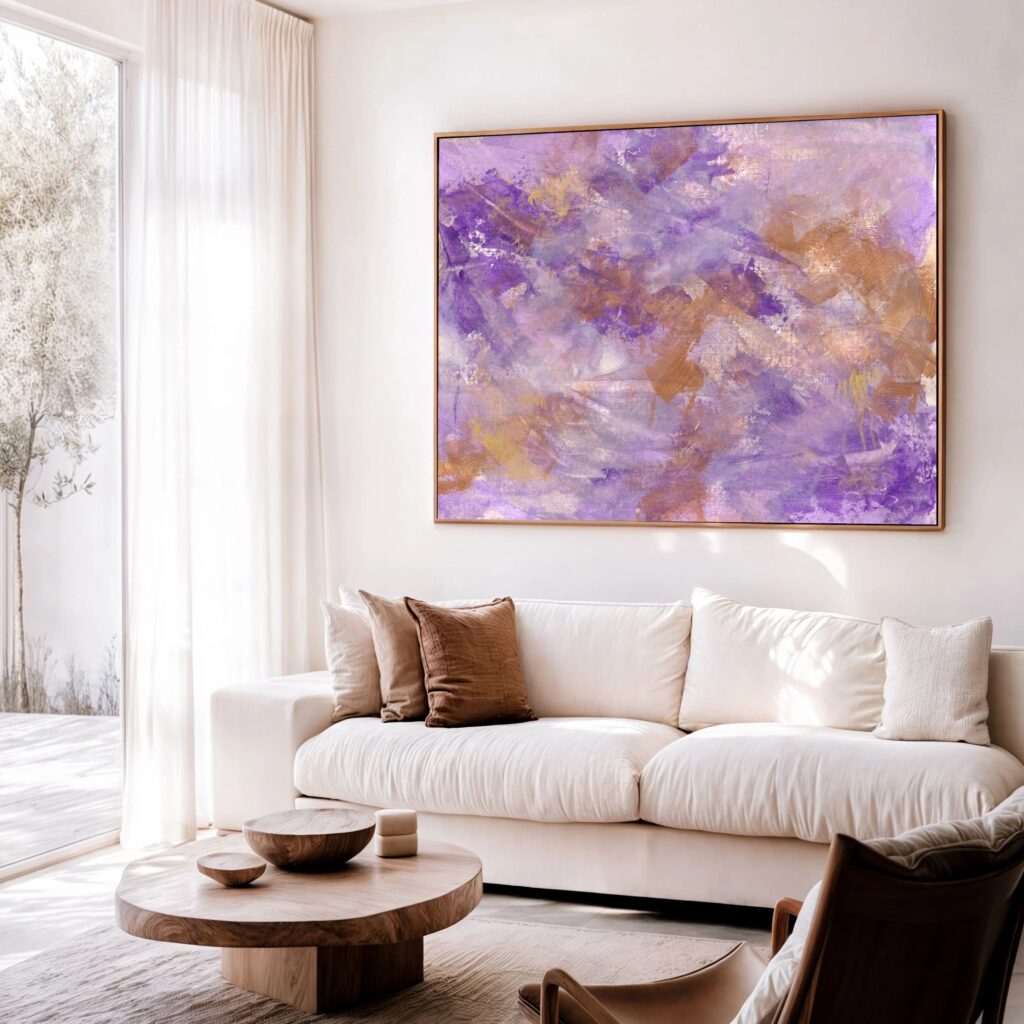
Art is the silent co-founder of culture
Office culture isn’t built by HR documents or Slack emojis. It’s built by how people feel in the space every single day.
Art, especially emotionally intelligent art, contributes to that culture by providing a felt sense of how emotions are held, seen, and allowed.
In emotionally disconnected spaces, the art is often generic, forgettable, or irrelevant. It says, “We’re not really thinking about what it feels like to be here.”
But when art is chosen with emotional intelligence, it becomes a kind of visual leadership. A quiet way of saying:
“We see you. We know you’re carrying a lot. This space is designed to support you, not just use you.”
That’s the kind of culture people don’t want to leave. That’s the kind of space clients want to come back to.
And that’s the kind of ROI you can’t fake.
How Emotionally Intelligent Art Impacts Focus and Cognitive Load
When people talk about productivity, they usually focus on output: how many tasks were completed, how fast a decision was made, how efficiently a meeting was run.
But underneath every one of those outcomes is an invisible layer of cognitive capacity.
And that capacity is directly impacted by how the brain and body are responding to the space, especially through the visual field.
Emotionally intelligent art is not a decorative flourish in this context. It’s a strategic tool for managing cognitive load, reducing visual fatigue, and increasing emotional recovery between cognitive tasks.
The myth of minimalism and the trap of “clean”
One of the biggest myths in office design is that a clean, minimal space automatically creates focus.
That’s not always true.
Minimalism, when done without emotional intelligence, can feel cold, sterile, or even hostile. It may reduce visual clutter, but it doesn’t necessarily invite presence.
Emotionally intelligent art bridges the gap. It introduces visual softness, organic rhythm, and aesthetic coherence, all without adding distraction.
The result? A space that supports focus not by eliminating all stimuli, but by introducing the right kind.
Cognitive load isn’t just about information
It’s about sensory input, emotional context, and internal processing speed.
In high-performance offices, employees are asked to switch tasks frequently, make rapid decisions, and manage competing priorities. This creates a phenomenon known as “cognitive switching cost”, a drop in performance when jumping from one mental context to another.
Emotionally intelligent artwork helps buffer this cost.
By offering visual anchors between tasks, such as a momentary glance at a spacious abstract, or a soft focal point during a break, the brain is able to reset more efficiently. It provides micro-regulation moments throughout the day.
Over time, these moments add up to significant gains in:
-
- Decision clarity
- Project stamina
- Emotional agility
- Strategic perspective
Focus is not force. It’s flow.
You can’t brute-force your way into flow state. But you can design for it.
Environments that encourage flow are environments that:
-
- Reduce unnecessary stimulation
- Provide soft, ambient visual rhythms
- Allow moments of internal recalibration
- Avoid high-contrast or jarring imagery
Emotionally intelligent art contributes directly to these conditions.
For example, in a space designed for high-concentration work, like legal research, financial planning, or therapeutic notes, a soft, expansive canvas placed within peripheral view can help regulate breathing and visual rhythm, both of which are essential for focus.
This is not about adding more to the wall. It’s about adding the right thing, in the right place, for the right reason.
Why “motivational” art fails here
Let’s address this directly: motivational posters, slogans disguised as artwork, and literal metaphors (“climb the mountain,” “break through the wall”) actually increase cognitive load, not decrease it.
They add a layer of emotional messaging that demands decoding. They pull focus. They create performance anxiety.
Emotionally intelligent art does the opposite. It allows space for your internal experience to exist without judgement, direction, or urgency.
It doesn’t ask you to feel inspired. It gives you the space to reconnect with what you already know.
That’s why it’s so powerful, and why so many offices are replacing their old “inspirational” pieces with work that holds stillness, not pressure.
Small moments, big impact
In a mindful office space, performance isn’t measured by hustle. It’s measured by clarity, depth, and presence.
Art that supports this doesn’t need to be monumental. One well-placed piece in a hallway can reduce tension between meetings. A small canvas above a desk can create an emotional reset without any disruption. A quiet piece behind a CEO’s desk can hold space for moments when words fail.
Over time, these micro-shifts become macro-changes. The space begins to feel different. Work begins to feel better. People begin to think more clearly.
And that clarity becomes your competitive edge.
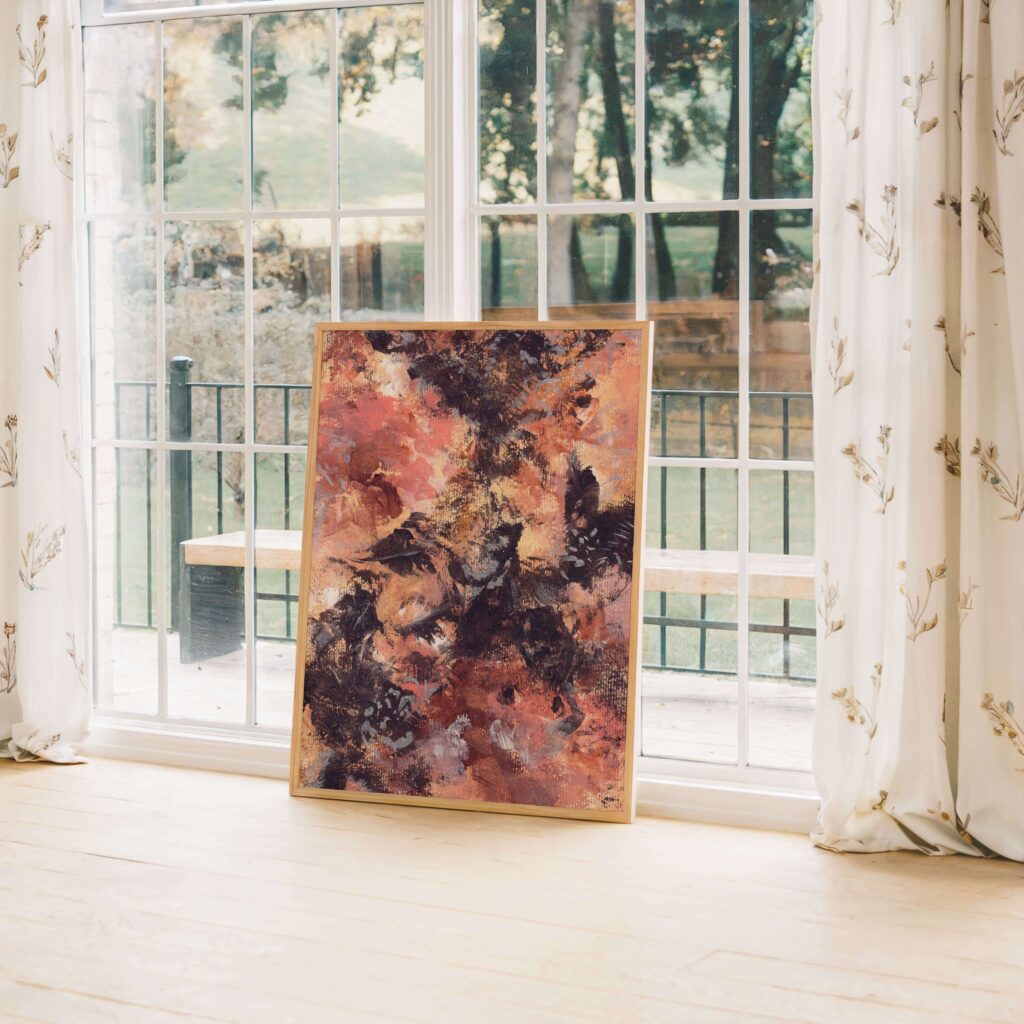
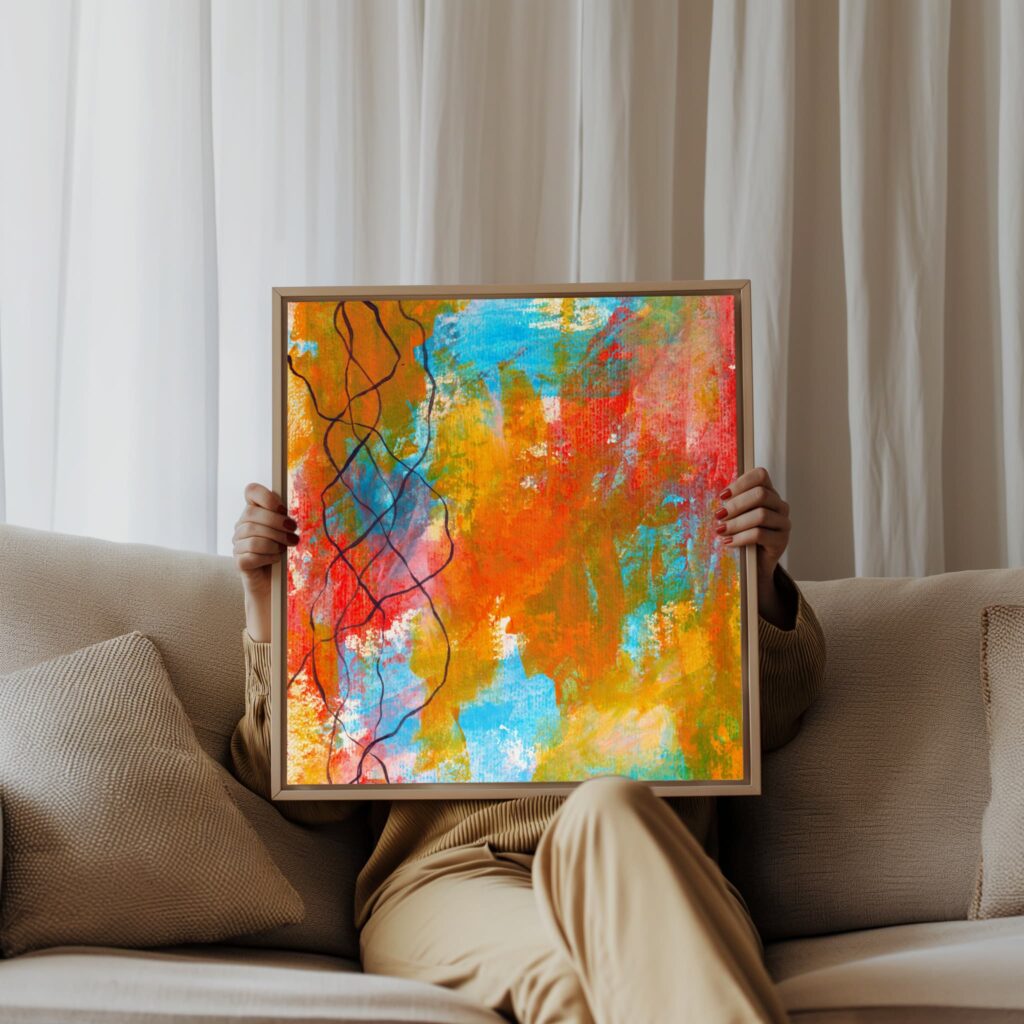
The Wellbeing Dividend: Mental Health, Stillness, and Stress Reduction
Let’s talk about something no quarterly report is showing, but every leader feels:
Your team is exhausted.
Not lazy. Not disengaged.
Exhausted.
Emotionally, neurologically, physiologically depleted.
And your workspace might be contributing to it.
This is where emotionally intelligent art becomes more than a design decision. It becomes a wellness intervention.
Because in high-performance environments, stillness is not a soft option. It’s a business-critical need.
Why stress recovery isn’t optional anymore
High-end workplaces often attract high-performing individuals. These are the people who take pride in their work, who push themselves, who handle pressure with apparent ease.
But no one, no matter how senior, seasoned, or “resilient”, is immune to chronic overstimulation.
And modern offices, for all their ergonomic chairs and branded snacks, are still incredibly overstimulating.
-
- Visual chaos (screens, signage, motion)
- Sonic clutter (open-plan noise, pings, HVAC hum)
- Emotional demand (constant urgency, unread Slack messages, expectations to self-regulate)
These conditions activate the sympathetic nervous system, the stress response, and keep people in a subtle but persistent state of vigilance.
Even if it’s not dramatic, it’s constant. And that’s the problem.
You can’t solve this by adding another meditation app or planning a wellness week. You solve it by designing spaces where people can naturally, physiologically, come down.
And that’s where emotionally intelligent art works as an ambient nervous system regulator.
What stillness actually means in a high-output space
Let’s be clear: stillness is not silence. Stillness is not emptiness. Stillness is the absence of agitation.
It’s the baseline the brain returns to when it’s not being yanked in ten directions. It’s the ground floor of creative thought, self-awareness, and emotional recovery.
In a mindful office, stillness should be felt as the default, not as a reward after a stressful day.
And emotionally intelligent art supports that by anchoring the space in visual stillness:
-
- Soft gradients instead of sharp contrast
- Gentle movement instead of high-density patterns
- Colour palettes that evoke safety, not urgency
- Compositions that create openness, not pressure
This creates a kind of invisible architecture, one that holds the space emotionally, even when the calendar is full and the stakes are high.
The neuroscience of visual restoration
A study by Biederman and Vessel (2006) found that exposure to aesthetically pleasing visual stimuli triggers reward responses in the brain, increasing dopamine and reducing stress hormones like cortisol.
Other studies in biophilic design show that natural textures, organic forms, and soft edges reduce cognitive load and improve emotional recovery after stress events.
Emotionally intelligent art mimics many of these patterns, particularly when created with intention. It offers a “visual exhale” that the nervous system recognises, even if the conscious mind doesn’t register it.
Think of it as mental breathwork, in visual form.
The impact on mental health outcomes
Workplaces that ignore emotional tone in their environments are quietly fuelling:
-
- Increased anxiety
- Executive burnout
- Decision fatigue
- Mood volatility
- Reduced empathy and collaboration
You may not see it on a spreadsheet, but you’ll feel it in:
-
- Passive-aggressive emails
- Staff turnover
- Missed strategic opportunities
- Client tension
- Lack of innovation
By contrast, workplaces that intentionally integrate emotionally intelligent artwork often report:
-
- Improved team morale
- Decrease in conflict
- Greater leadership composure
- Improved clarity during high-stakes decisions
- A more emotionally “clean” atmosphere
- These aren’t just HR wins. They’re strategic advantages.
Because in emotionally regulated teams, the conversations go deeper, the feedback is clearer, and the vision is easier to hold, even under pressure.
A CEO’s office without walls
A managing director at a boutique investment firm redesigned his corner office to feel “less like a fortress and more like a sanctuary.”
He removed all branding. He reduced the visual density. And he installed one abstract piece, emotionally grounded, textural, cool-toned.
That one canvas did more than warm up the room. It changed the tone of every meeting.
Team members started saying things like:
“This feels like a space I can think in.”
“It’s weird, but I feel calmer when I sit down here.”
“I don’t dread our reviews anymore.”
It wasn’t magic. It was emotionally intelligent design, with emotionally intelligent art as the anchor.
The wellbeing dividend here wasn’t just “happier people.” It was clearer strategy, smoother conflict navigation, and less time recovering from emotionally charged decisions.
And it cost less than a leadership offsite.
How this plays out in different industries
In law:
Where analytical thinking must coexist with high emotional charge, emotionally intelligent art creates pockets of neutrality. It prevents burnout in associates and creates spaciousness for client-facing rooms where stress runs high.
In consulting:
With constant pitch pressure and strategy shifts, emotionally intelligent art grounds leadership and teams alike. It becomes a way to reset between intellectual sprints.
In therapy and wellness fields:
Stillness is the entire point. Art here can’t just be decorative. It must hold space, gently regulate, and provide a wordless container for complex emotional processing.
In medical settings:
Clinics and private practice rooms benefit immensely from emotionally intelligent art, especially for staff wellbeing. While patient-focused design gets attention, the staff rooms are often neglected. Art in these back-of-house spaces can transform mental recovery in a single shift.
In high-stakes finance:
Even in spaces that pride themselves on toughness, emotional regulation is key. Traders, analysts, and client-facing staff need moments of internal recovery to avoid emotional reactivity. Subtle art placements, especially in rest areas and break rooms, can profoundly shift internal tone.
This isn’t about trend. It’s about function.
Emotionally intelligent art works differently in each setting, but the goal is always the same: emotional recovery without effort.
Stillness is the new scalability
In a work culture obsessed with scale, speed, and productivity hacks, stillness might seem irrelevant.
But it’s not.
It’s the missing ingredient that makes everything else sustainable.
You can’t scale strategy on a burnt-out brain. You can’t scale clarity inside an emotionally noisy room. You can’t scale high-performance teams if the environment is undermining their nervous systems.
Stillness doesn’t slow down growth. It makes it possible.
And emotionally intelligent art makes stillness tangible, not as a luxury, but as a structural asset.
Summary: The ROI of restoration
Here’s what emotionally intelligent art offers in the context of mental health and stillness:
-
- Faster emotional recovery from meetings, conflict, and mental fatigue
- Reduction in staff burnout through consistent visual regulation
- Increased clarity during strategic work by lowering stress hormones
- Improved staff retention by creating spaces people actually want to work in
- Client trust through emotionally congruent atmospheres
You don’t need a giant budget. You need intentionality.
And in spaces where performance is demanded daily, that intention needs to include emotional safety.
Stillness, presence, and restoration are not counter to productivity, they are its deepest support.
And in high-end workspaces designed for mindfulness, emotionally intelligent art is the visual form of that support.
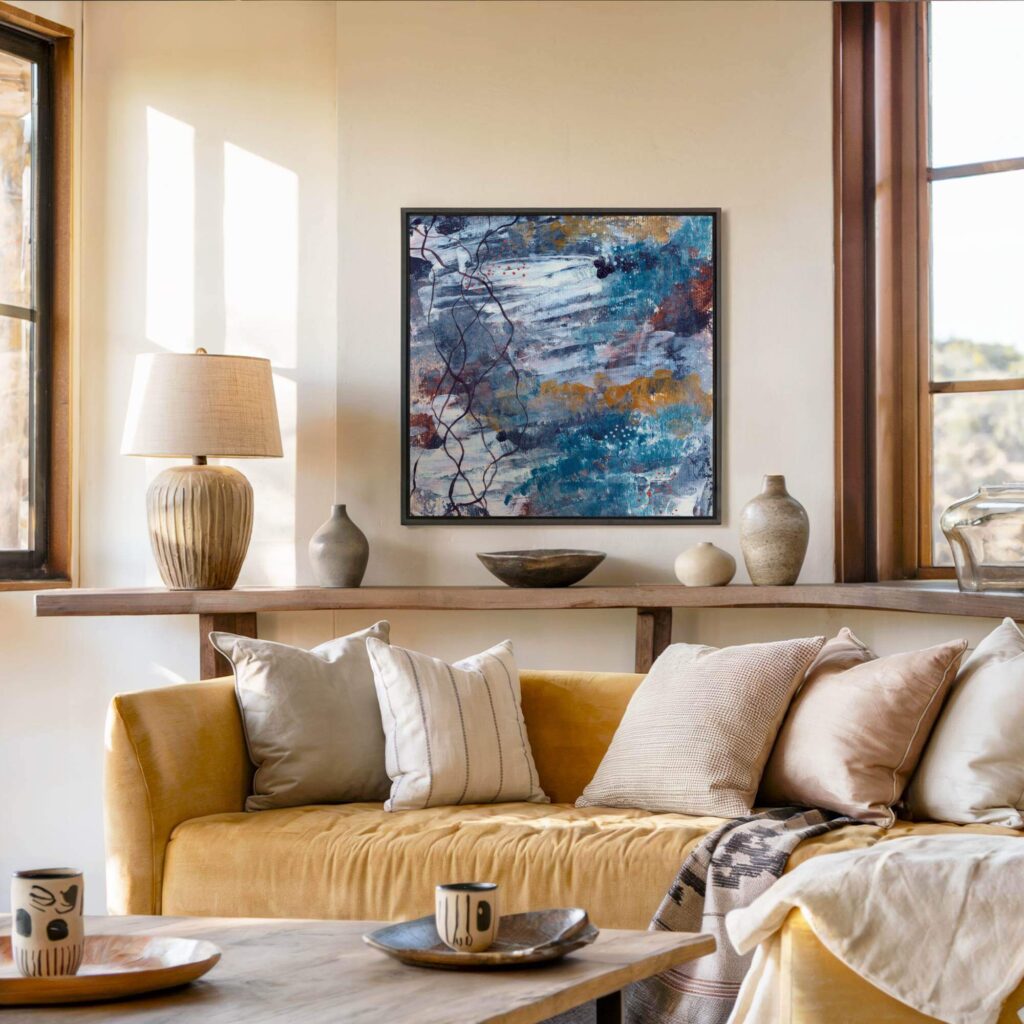
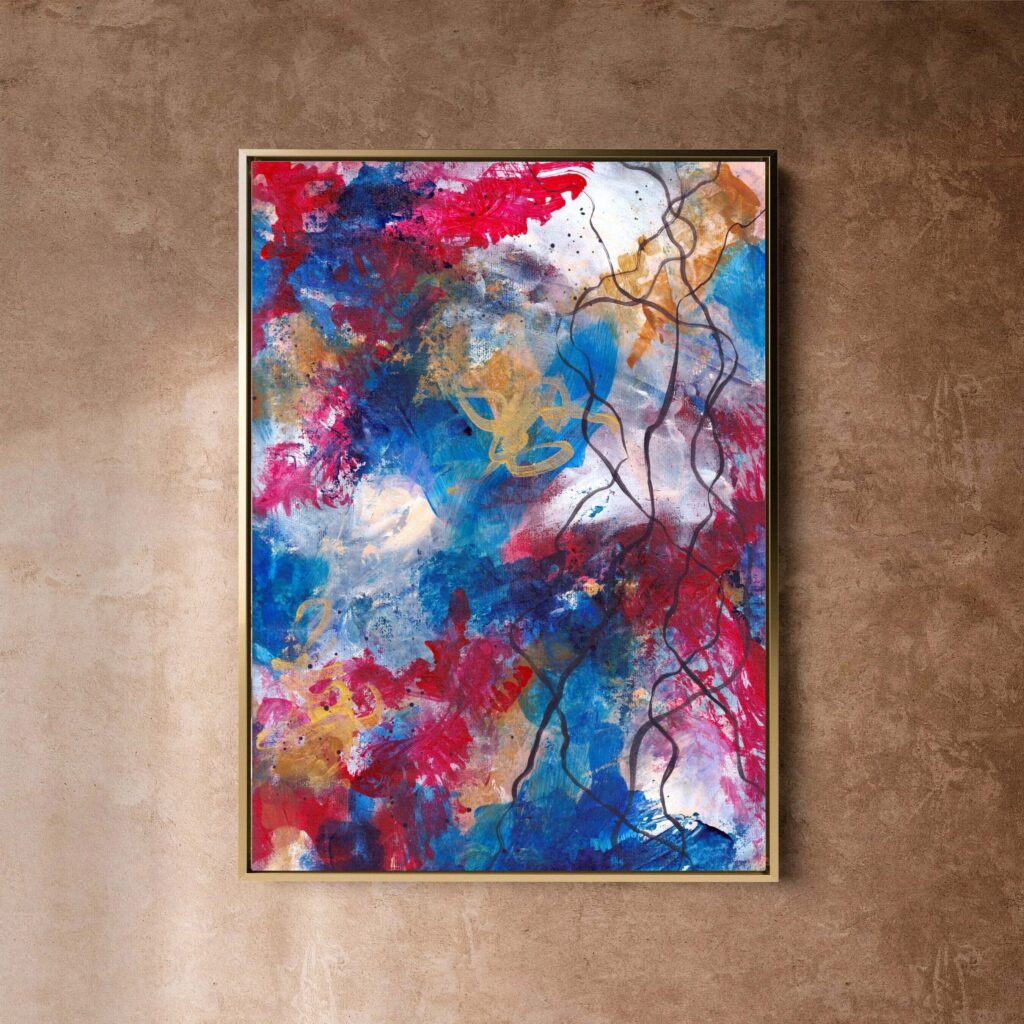
How to Know if a Piece Is Truly Luxury
Let’s get one thing straight:
Your brand isn’t your logo.
It’s not your tone of voice.
It’s not even your website.
Your brand is what people feel in the first 10 seconds of being in your presence.
And if your workspace is part of that presence, whether that’s a client meeting room, a founder’s suite, or a quiet consultation space, then your art is speaking before you ever open your mouth.
Emotionally intelligent art makes sure it’s saying the right thing.
Because in the high-end B2B space, people aren’t just buying services. They’re buying emotional alignment. They’re investing in how your presence makes them feel, calm, clear, safe, seen.
Art for mindful office spaces becomes one of the clearest, fastest, and most emotionally trustworthy expressions of brand identity you’ll ever invest in.
Here’s how it works.
People don’t remember your pitch. They remember your presence.
We like to think we’re logical, especially in business. But the truth is, emotional tone shapes decision-making more than any slide deck or service breakdown.
What does that mean in real terms?
It means:
-
- A calm boardroom gets more yeses than a chaotic one.
- A founder’s office that feels emotionally steady builds trust faster.
- A consultation space that feels emotionally honest allows deeper dialogue.
These aren’t just preferences. They’re psychophysiological truths.
And emotionally intelligent art helps anchor the space in that emotional truth, without needing to “sell” anything.
Your environment reflects your values, whether you like it or not
Let’s say a client walks into your office for the first time.
What do they see?
-
- Is it a sleek, high-gloss environment with abstract art so cold it feels robotic?
- Is it a cluttered startup space with neon slogans trying too hard to be clever?
- Or is it a spacious, intentional atmosphere that feels like it has emotional depth?
They’re not consciously judging your art. They’re subconsciously receiving its tone.
And that tone is telling them something about your values:
-
- Do you care about nuance?
- Do you value clarity without chaos?
- Are you operating from integrity or from performance?
Art for mindful office spaces communicates these things instantly. Not because it says them, but because it holds them.
Emotional congruence = brand trust
In marketing psychology, “congruence” refers to alignment between what you say and what you do. When people sense congruence, they trust you more. When they sense dissonance, they doubt you, even if they can’t explain why.
If you say you care about wellbeing but your space feels cold and overstimulating, that’s dissonance.
If you say your firm supports conscious decision-making but your environment is loud, fast, and emotionally thin, that’s dissonance.
Emotionally intelligent art helps you close that gap.
It visually aligns your emotional presence with your strategic messaging. And it helps your clients feel what your brand claims to offer, before you’ve even started the conversation.
Why luxury brands are adopting emotional depth
Historically, luxury branding has been about status, exclusivity, and visual dominance.
But the new wave of luxury is emotional.
It’s about feeling seen. Feeling grounded. Feeling restored.
You’ll see this shift in high-end hotels, private medical practices, founder-led brands, and boutique consultancies. They’re not just offering outcomes. They’re offering emotional states.
-
- Calm
- Presence
- Clarity
- Confidence
And the environments they curate, including the art, are chosen not just to impress, but to regulate.
Because nothing feels more luxurious than being able to breathe.
The fastest way to sabotage your brand? Generic art.
Let’s be blunt. There is nothing more emotionally deadening than walking into a well-designed office and seeing a mass-produced canvas print of a tree, a cliché inspirational quote, or a meaningless abstract that looks like it came from a hotel clearance bin.
These pieces don’t just fail to impress. They actively work against your brand.
They say:
-
- “We didn’t think this through.”
- “We wanted to tick a box.”
- “This doesn’t really matter to us.”
That’s not the message you want to send.
Especially if your clients are emotionally intelligent, perceptive, and sensitive to tone, and in high-end B2B environments, they often are.
You don’t need famous names. You need resonance. Depth. Intentionality.
That’s what emotionally intelligent art delivers.
From clinical to connected: one example
An executive coaching practice in London was known for its world-class frameworks and elite clientele. But the office? It felt like a law firm in 2008, grey walls, sharp lighting, generic prints.
Clients felt tense in the space. Sessions felt rushed. Conversations stalled.
After a redesign led by a wellbeing-focused interiors team, the space was stripped back. Lighting was softened. Furniture was rearranged for comfort. And three pieces of emotionally intelligent abstract art were installed in strategic places: the entrance, the consultation room, and the founder’s office.
The shift was immediate:
-
-
Clients began commenting that “it feels calmer here.”
-
Sessions ran deeper, faster.
-
Retention increased.
-
Referrals went up.
-
The only thing that changed? The emotional tone of the space, and the artwork that anchored it.
That’s the power of congruence.
The client experience is now emotional real estate
Think about the journey your client takes:
-
-
They enter your building. What’s the first thing they feel?
-
They sit in your waiting area. Are they being overstimulated or allowed to settle?
-
They walk into your office. Are they met with harsh visuals or gentle presence?
-
Every step is a chance to regulate or dysregulate.
Every visual cue contributes to the emotional narrative they build about your firm.
When you invest in art for mindful office spaces, you’re investing in emotional architecture. You’re telling your clients:
“This space has been designed with intention. We’ve thought about what it feels like to be here. We care about your experience, not just your outcome.”
And in a marketplace flooded with competitors, that level of care is what sets you apart.
Emotionally intelligent clients notice the details
If your clients are creatives, therapists, founders, wellness leaders, impact investors, or senior women in leadership, chances are they are highly attuned to emotional nuance.
They won’t tell you your art is wrong. They’ll just sense that something feels off.
Or they’ll feel the opposite, that something feels unexpectedly right.
That they can breathe in your space. That the conversation flows more easily. That they feel more like themselves.
And they’ll attribute that to you. To your leadership. To your emotional intelligence.
That’s brand value you can’t fake. And emotionally intelligent art helps build it, quietly, faithfully, powerfully.
From aspirational to embodied
A lot of firms talk about values. Fewer embody them.
Art becomes the bridge between the two.
Instead of telling people you value presence, you create it.
Instead of claiming you support emotional wellbeing, you show it.
Instead of pitching yourself as “different,” you make that difference felt the moment they enter the room.
This is especially powerful in industries that have historically been emotionally distant, law, finance, tech, academia.
When a client walks into your space and feels the emotional congruence between your claims and your atmosphere, their nervous system relaxes.
And relaxed nervous systems make better decisions.
Summary: Let your space speak for you
Here’s what emotionally intelligent art does for your brand:
-
-
Visually reflects your values without performance
-
Creates immediate emotional resonance with clients
-
Sets you apart from generic or overstimulating competitors
-
Builds trust before any words are spoken
-
Embeds emotional intelligence into your physical presence
-
If your firm is future-focused, emotionally aware, and values-aligned, but your space doesn’t reflect that, now is the time to change it.
Because your brand isn’t just what you say.
It’s what people feel when they’re with you.
And art for mindful office spaces is one of the fastest, most authentic ways to shape that feeling.
My Offerings for Discerning Buyers & Designers
I’ve worked with interior designers, luxury hotels, executive teams, and private collectors who value emotional depth, spatial harmony, and long-term resonance. I offer:

Collector's Vault
Canvas prints from the archive, made with emotional resonance and sustainable materials for spaces seeking depth.
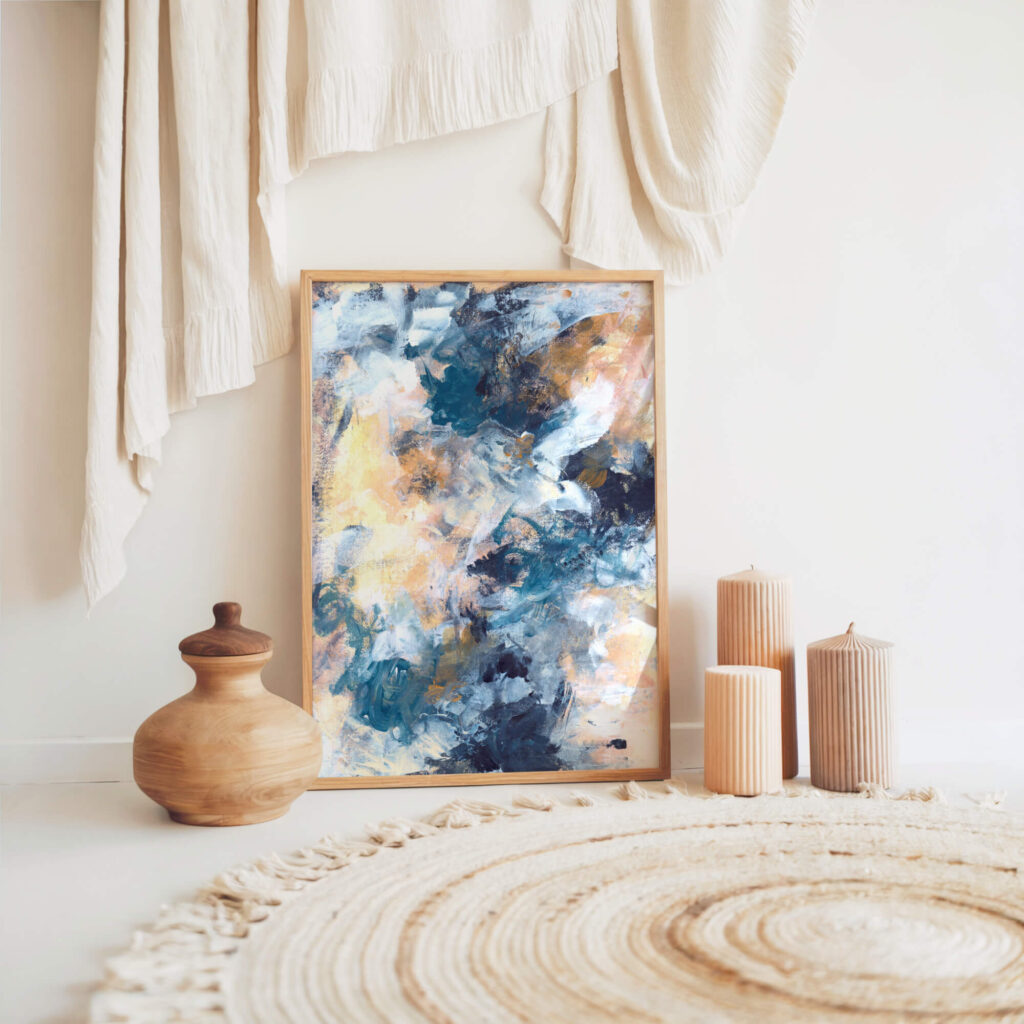
Capsule Commission
Created privately, one at a time, through stillness and reflection. Limited spaces each season to preserve depth and intimacy.
The Last 10
Ultra-limited, hand-embellished editions. No more than ten will ever exist. Made to ground, steady, and hold presence at the highest tier.
From Burnout to Belonging: Art That Rehumanises the Workplace
For all the conversations around high performance, innovation, and team cohesion, there’s an uncomfortable truth that too many leadership teams still ignore: most burnout doesn’t begin with overwork. It begins with emotional disconnection.
It begins when people no longer feel fully human in the environments where they spend their days. It begins when the workplace asks for output but offers no emotional nourishment. It begins when spaces are designed to optimise function, but never consider feeling.
And for many teams, that disconnection starts in the visual field.
When people are surrounded by overstimulation, generic art, and emotionally flat environments, their nervous systems never get the chance to recalibrate. They remain slightly braced, slightly guarded, slightly outside themselves, and over time, that subtle detachment becomes a chronic condition.
Emotionally intelligent art is one of the few design elements that can disrupt that drift. Not by demanding attention, but by restoring safety. It reintroduces softness, depth, and emotional recognition into environments that have forgotten how to hold them. When thoughtfully integrated, it doesn’t just improve the aesthetic of a workspace, it helps people return to themselves inside it.
This is how art for mindful office spaces moves from being a visual choice to a cultural strategy.
Why Belonging Is a Biological Need, Not a Perk
Belonging is often framed as a culture-building goal, something companies aim to “encourage” through policies, initiatives, or internal events. But in reality, belonging is a physiological state, a felt sense of emotional safety and recognition that arises when the nervous system perceives its environment as non-threatening, responsive, and emotionally congruent.
It doesn’t take a branded campaign to create that feeling. It takes spaces that speak the right emotional language.
When an office is designed with emotionally intelligent principles, every element, from the layout to the lighting to the artwork, contributes to a sense of groundedness. There’s less cognitive static. Less emotional friction. And as a result, people begin to relax into the space rather than brace themselves against it.
That softening isn’t laziness. It’s the biological baseline required for sustainable focus, genuine collaboration, and clear-headed leadership.
The Burnout That Happens in Beautiful Offices
One of the great ironies of contemporary office design is that even the most visually polished spaces can contribute to burnout. In many cases, aesthetic minimalism is mistaken for emotional intelligence. But visual simplicity, without emotional depth, can actually reinforce the very pressures it aims to relieve.
When a space is pristine but cold, elegant but emotionally hollow, it sends a subtle message to the people inside it: maintain composure. Perform well. Don’t disrupt the atmosphere.
This kind of unspoken pressure compounds over time. People begin to perform their professionalism more than they embody it. Emotional authenticity is traded for polish. And while the office may look calm on the surface, it’s carrying a quiet undercurrent of anxiety that never fully dissipates.
Emotionally intelligent art counters that pressure by offering a different kind of presence one that doesn’t ask anything of the viewer. It sits quietly. It doesn’t posture or instruct. It doesn’t need to be interpreted. It simply holds space. And that spaciousness becomes a powerful permission slip for the people inside it.
The Unpaid Tax of Emotional Labour
In emotionally demanding industries, consulting, healthcare, therapy, strategy, leadership, the invisible labour is not just intellectual. It’s emotional.
Employees and executives alike are absorbing tension, managing interpersonal friction, translating ambiguity into clarity, and suppressing their own reactions for the sake of professionalism. This constant, low-grade output of emotional energy is rarely acknowledged in performance reviews or productivity metrics. But it is deeply felt, and it is profoundly draining.
Workspaces that do not acknowledge this load, visually, spatially, or culturally, become extractive. Over time, team members may still be showing up. But they’re no longer fully present. They’re emotionally thin, disconnected from purpose, and increasingly resistant to deeper collaboration.
When art for mindful office spaces is chosen with emotional labour in mind, it doesn’t just decorate a wall. It creates a restorative pause. A soft landing. A visual co-regulator that helps people stay emotionally tethered throughout the day. It provides micro-moments of anchoring that reduce the internal cost of emotional giving, and those moments add up.
Shifting From Performance to Presence
One of the most powerful shifts a workplace can make is moving away from a culture of constant performance and into one of grounded presence. In performance-driven cultures, every moment is a metric. Every interaction is an opportunity to impress. Every space feels like it’s quietly watching.
But people do not thrive in environments that constantly require performance. They thrive in environments that make space for them to be, to think, feel, process, and lead without fear of emotional exposure or image misalignment.
Emotionally intelligent art signals that shift in tone. When placed intentionally, it helps establish a room not as a stage, but as a container. It reduces the implicit demand for output and replaces it with a felt permission to arrive fully.
And that, in turn, unlocks the very qualities performance cultures crave but can never quite cultivate, clarity, resilience, creativity, empathy.
Designing for Emotional Permission
For a team to feel like it belongs in a space, the space must allow for emotional reality, not just emotional optics.
This means recognising that your people will arrive each day in varying states of clarity, confidence, and calm. They will carry with them personal tensions, unspoken fears, and unconscious stress. If the environment reinforces the idea that only one emotional state is acceptable, namely, “fine”, then emotional fragmentation becomes the norm.
But when the environment acknowledges emotional range, even silently, it helps build trust.
Emotionally intelligent art does this not through literal imagery or identity signaling, but through openness. Through abstraction, texture, spaciousness, and depth, it communicates the message: there is room for you here, even if you’re not at your best.
And that kind of nonverbal validation is often more powerful than any check-in or training module.
A Story of Reconnection Through Design
A leadership team at a mid-sized strategy firm had been struggling with emotional disconnection post-pandemic. People were back in the office, but the energy felt flat. Meetings were efficient but uninspired. Conversations were professional but emotionally hollow.
Instead of planning another team-building event, the founder worked with a studio to redesign the office environment, integrating emotionally intelligent artwork throughout. In meeting rooms, large-scale abstract pieces were installed, textured, quiet, and layered. In private offices, smaller works were chosen to reflect the emotional tone of the individual leader.
The results were immediate. Teams started lingering after meetings. Difficult conversations softened. One employee said, “It’s weird, but I actually feel more like myself here again.”
No strategy changed. No new tools were introduced. But the emotional tone of the space shifted, and with it, the tone of the work.
Art as Micro-Recovery for Emotional Strain
Most emotional recovery at work doesn’t happen during time off or retreats. It happens in small, unnoticed moments between tasks. The pause between meetings. The deep breath before a call. The quiet minute after reading a stressful email.
These moments are the nervous system’s opportunity to recalibrate, but only if the environment allows it.
Art for mindful office spaces creates the conditions for those recalibrations. A soft focal point can slow the breath. A layered composition can restore attention span. A gentle, emotionally resonant visual can remind someone, however briefly, that they are more than their output.
Over the course of a day, these micro-interventions support resilience. Over the course of a year, they change culture.
How Belonging Impacts Loyalty
It’s easy to assume that retention is about salaries, perks, or advancement opportunities. But in emotionally intelligent teams, loyalty is often based on something quieter, how people feel when they walk into the space each day.
If the space feels agitating, cold, or performative, people will begin to emotionally detach, even if the work is meaningful. But if the space feels regulating, humane, and emotionally grounded, people stay connected. They take more ownership. They contribute more fully. Not because they’re being managed well, but because they feel held.
Art isn’t the only factor in this dynamic. But it is one of the fastest, most cost-effective ways to transform the emotional tone of a space without overhauling the entire structure.
When chosen with clarity, emotionally intelligent artwork helps people feel like they belong, not performatively, but somatically.
And that kind of belonging doesn’t just keep people in the room. It keeps them in relationship with the work.
Let the Walls Do Some of the Holding
In emotionally intelligent leadership, one of the key principles is distributed responsibility, making sure no single person is carrying the full weight of emotional regulation in a team.
But that responsibility doesn’t just sit with people. It sits with the space.
When your physical environment holds emotional awareness, when the walls themselves feel like they know what it means to be human, then the people inside it don’t have to over-function just to keep things civil. The space itself becomes a co-regulator.
That’s the kind of subtle brilliance emotionally intelligent art brings to mindful offices. It reduces the emotional temperature. It absorbs some of the charge. It offers softness in a room that would otherwise feel tight.
In this way, art becomes more than visual. It becomes architectural support for the emotional culture you’re trying to build.
Rehumanising the Workplace Is Not a Trend, It’s the Future
We’re entering an era where presence is more valuable than performance. Where clarity outpaces charisma. Where emotional intelligence isn’t just a skill, it’s a strategy.
In this new paradigm, the workplaces that succeed will be the ones that feel human to be inside. That means fewer gimmicks, fewer slogans, and more depth.
Emotionally intelligent art helps build that depth. It reintroduces texture to flat environments. It invites people to reconnect with themselves. It creates space where emotional reality is recognised, not just tolerated, but welcomed.
And for the people working inside these spaces, that recognition changes everything.
They don’t just feel like employees. They feel like people.
They don’t just meet deadlines. They meet themselves.
And in the economy of future work, where presence, creativity, and clarity are the true currency, that kind of human-centred design isn’t just a nice-to-have. It’s a competitive advantage.
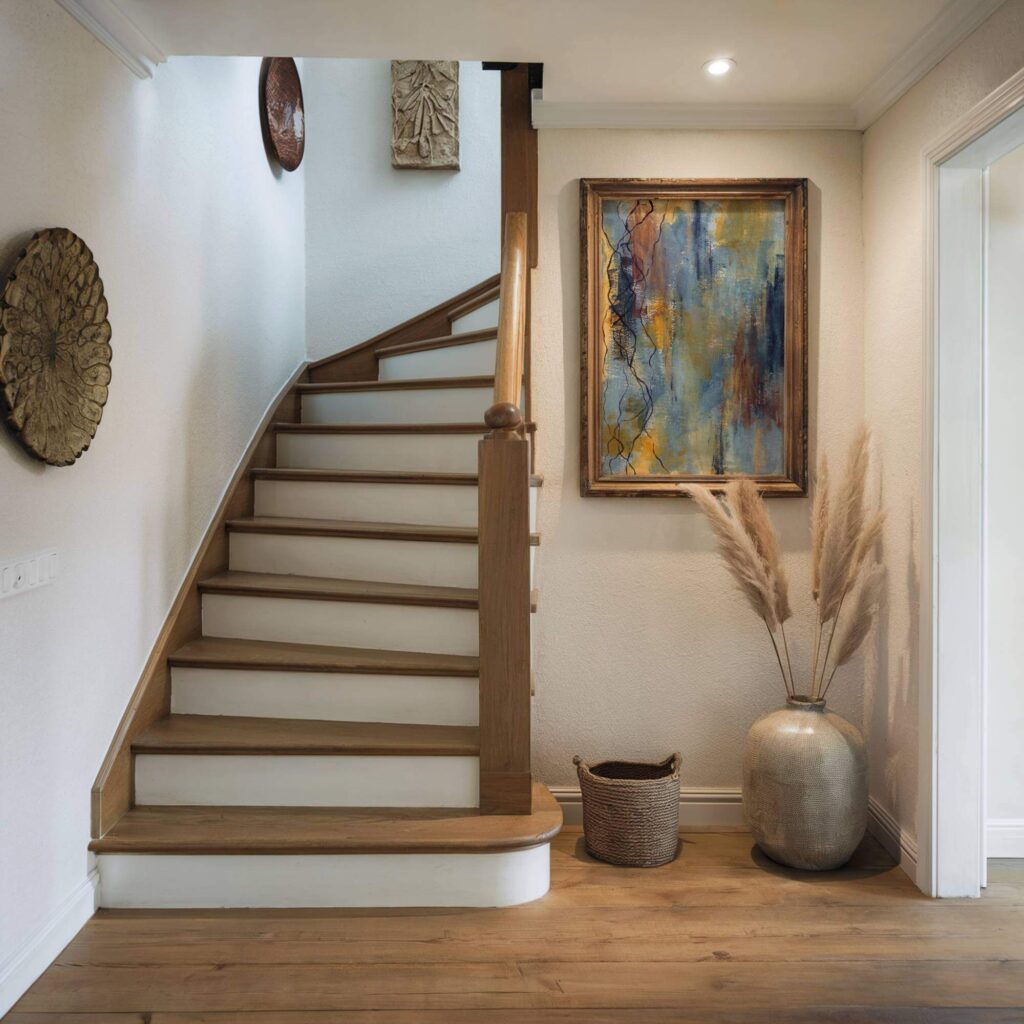

Measurable ROI: Retention, Creativity, and Strategic Clarity
There’s a persistent myth in the world of office design that emotionally intelligent environments are somehow nice but not necessary, that art, atmosphere, and aesthetic depth belong in the realm of culture, not strategy. The truth is much sharper. Emotionally intelligent design, and especially emotionally intelligent art, is not a luxury. It is a performance multiplier. It changes how people think, collaborate, and stay.
In high-performance work environments, return on investment is often measured in hard numbers, revenue growth, client acquisition, billable hours, project completions. But behind every one of those metrics is a team. And behind every team is a nervous system. When that system is constantly braced, depleted, or dysregulated, performance suffers, quietly at first, then systemically.
By integrating emotionally intelligent art into mindful office spaces, leaders are discovering a surprisingly direct path to higher retention, deeper creativity, and sharper strategic execution.
This is not an abstract benefit. It’s an operational one.
The Real Cost of High Turnover
Recruitment costs are measurable. Onboarding inefficiency is trackable. But the emotional cost of staff turnover is harder to quantify, and just as damaging.
Every time a talented employee leaves, the organisation doesn’t just lose skills. It loses continuity, trust, and internal coherence. The remaining team absorbs the emotional disruption, the workload redistribution, and the psychological signal that this may not be a sustainable environment.
When workspaces are emotionally intelligent, these exits happen less often. Not because people are pacified, but because they are grounded. They are given the physiological conditions to work through challenges without burning out. They are reminded, through the atmosphere, that they matter, not just as producers, but as people.
Emotionally intelligent art plays a key role in this process. It creates micro-environments of stability. It offers sensory cues that balance the constant demands of high-responsibility roles. It reduces the chronic overstimulation that quietly pushes people toward disengagement.
In organisations where attrition is even mildly problematic, this kind of preventative architecture is not an indulgence. It’s a cost-saving necessity.
Why Creative Thinking Requires Emotional Regulation
Creativity is often misunderstood as a personality trait, something innate to certain roles or individuals. In reality, creative problem-solving, ideation, and innovation are cognitive functions that depend heavily on emotional regulation.
When someone feels safe, calm, and emotionally present, their brain becomes more flexible. They make unexpected connections. They explore alternatives without fear of failure. They become more willing to share ideas and build on others’ thinking.
But in environments that are visually jarring, emotionally flat, or pressure-heavy, the opposite happens. People shut down. They default to old patterns. They become reactive instead of expansive.
This is where art for mindful office spaces becomes a direct contributor to innovation. By offering visual and emotional stimuli that support calm, openness, and internal coherence, emotionally intelligent art helps sustain the conditions that make creativity possible.
It doesn’t need to be themed. It doesn’t need to show “inspiration” or “thinking outside the box.” It just needs to hold the nervous system in a state that allows flexibility and play. That’s where your next great idea lives, and that’s the environment where it can finally show up.
Strategy Requires Stillness
In high-level decision-making, noise is the enemy. Not just auditory noise, but cognitive and emotional clutter. When a leader sits down to make a strategic call, their thinking must be sharp, clear, and expansive. That level of clarity requires internal stillness, a rare commodity in most office environments.
Open-plan layouts, visual overstimulation, and hyper-productivity aesthetics all contribute to a sense of urgency. They cue the body into fight-or-flight. And in that state, we don’t think long-term. We think fast. We choose the safest or most familiar option. We solve problems in straight lines, not nuanced curves.
If a strategy meeting happens in a space that feels energetically chaotic, the outcomes will reflect that chaos.
Art that holds stillness, visually, spatially, and emotionally, creates a different result. It slows down the nervous system just enough for complex thinking to surface. It provides a felt sense of permission to stay with the ambiguity a little longer. And it creates a subtle but powerful emotional context that invites integrity, not impulsivity.
When that kind of art becomes part of the room, in executive offices, boardrooms, or one-on-one consulting spaces, the quality of thinking improves. Decisions take on more dimension. Conversations become more generative. And long-term strategy finally has space to emerge.
The Data Is Catching Up
While emotionally intelligent design is often led by intuition and experience, the data is now starting to reflect what many leaders have known for years: emotional context affects performance outcomes.
Studies in environmental psychology, neuroscience, and behavioural economics have confirmed:
-
-
Visual environments with natural forms, soft textures, and abstract art reduce cortisol levels, leading to better stress management and clearer thinking.
-
Emotionally congruent spaces improve perceived trustworthiness in leadership, which correlates with stronger engagement and psychological safety.
-
Workspaces that support emotional regulation increase team resilience and reduce reactive decision-making in times of pressure.
-
Art placed intentionally within line-of-sight can improve focus recovery during task-switching, one of the biggest productivity drains in hybrid environments.
-
What this means is that every carefully selected piece of art in your office, every canvas, every composition, every visual moment, becomes part of the invisible architecture supporting your business goals.
It’s not decor. It’s infrastructure.
An Example from Leadership Coaching
A boutique leadership development consultancy recently reconfigured its studio with the intention of reducing founder exhaustion and improving strategic clarity. Rather than invest in another coaching certification or CRM upgrade, they redesigned the office.
They integrated emotionally intelligent artwork into three zones:
-
-
A deep grey, layered abstract canvas in the founder’s office to ground decision-making and reduce emotional overload between client sessions.
-
A pale, open composition in the shared workspace to reduce visual fatigue and support quiet focus.
-
A warm, earth-toned piece in the client welcome area to create immediate regulation upon arrival.
-
Within three months of this shift:
-
-
Client satisfaction increased (measured through session feedback)
-
Session retention improved
-
The founder reported fewer decision delays and more internal clarity
-
No new service was launched. No price change was made.
The only change was emotional infrastructure.
And it paid for itself ten times over, through clarity, retention, and capacity.
A Cost Breakdown That Makes Sense
Let’s look at an example. Suppose a mid-sized executive consultancy hires three new team members each year, with an average onboarding and recruitment cost of £15,000 per employee.
If emotionally intelligent design, including art for mindful office spaces, reduces attrition by just one employee per year, the installation has already paid for itself.
Now add to that:
-
-
The value of improved client experience, leading to higher referral rates
-
The reduction in sick days related to stress and burnout
-
The increased project efficiency through clearer communication and reduced tension
-
The preservation of institutional memory through better retention
-
Suddenly, a £2,500 artwork commission or a £6,000 multi-piece installation looks like one of the smartest investments a business can make, not in vanity, but in viability.
Not Everything That Counts Can Be Measured, But Some of It Can
It’s easy to dismiss emotionally intelligent art as too soft to be strategic. But that’s only true if you’re not paying attention to what’s really draining your team.
Look at your metrics:
-
-
High churn?
-
Long strategy cycles?
-
Client experience plateauing?
-
Leaders stuck in decision loops?
-
Creativity declining despite capability?
-
These are not personality problems. They are environmental ones.
And art can help solve them.
That doesn’t mean buying whatever canvas matches your furniture. It means designing with emotional impact in mind, choosing pieces that regulate, restore, and resonate with the actual emotional tone of your business.
When done well, the results aren’t just visible. They’re felt. And they last.
Summary: Emotional ROI Is Business ROI
Here’s what art for mindful office spaces delivers, in real, trackable, strategic outcomes:
-
-
Reduced attrition through emotionally supportive environments
-
Improved strategic thinking through stillness and clarity
-
Increased innovation through physiological regulation and reduced stress
-
Enhanced client experience through emotional congruence
-
Better internal communication through lower ambient emotional tension
-
Faster project execution due to reduced emotional distraction and fatigue
-
And behind every one of these is the same truth:
People perform better when their emotional reality is recognised, not ignored, not flattened, and not pushed aside in the name of productivity.
Emotionally intelligent art helps make that recognition structural.
It makes it visible.
It makes it real.
And that reality is what gets results.
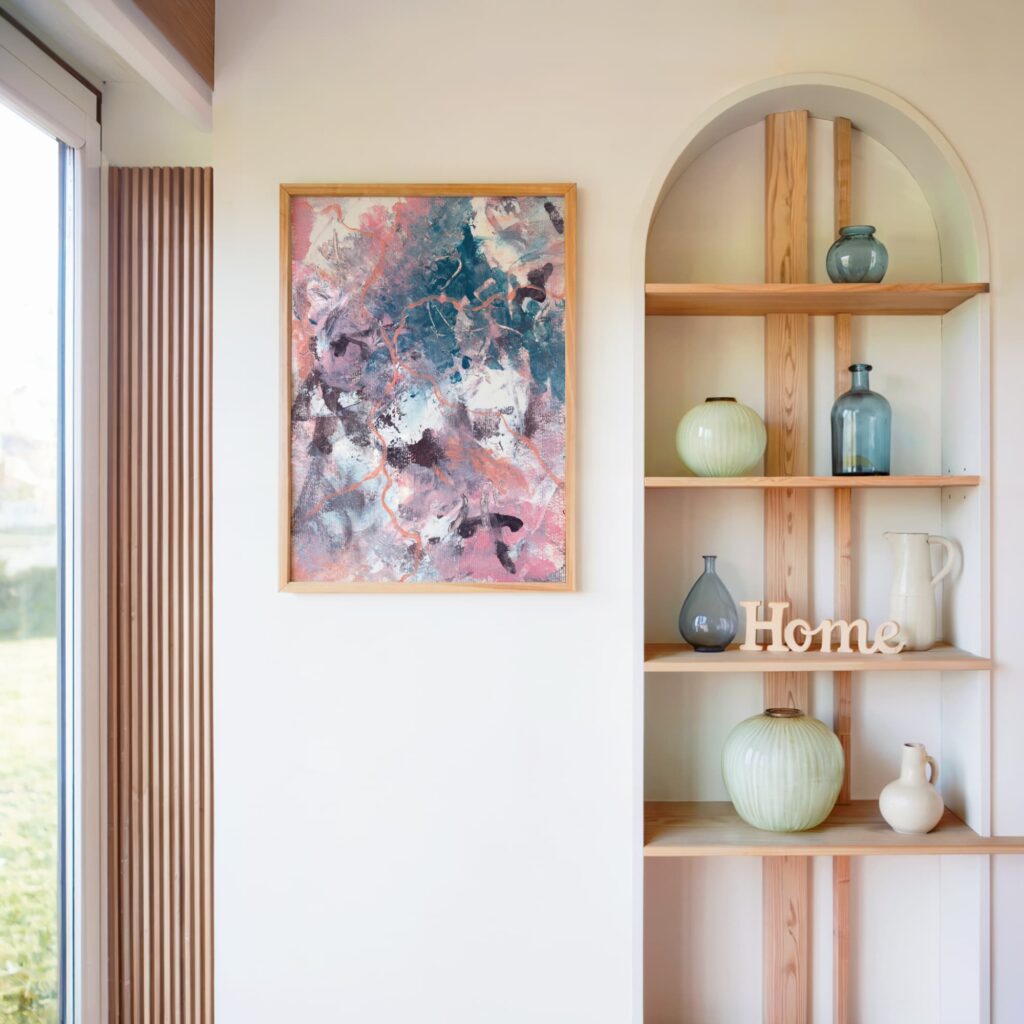
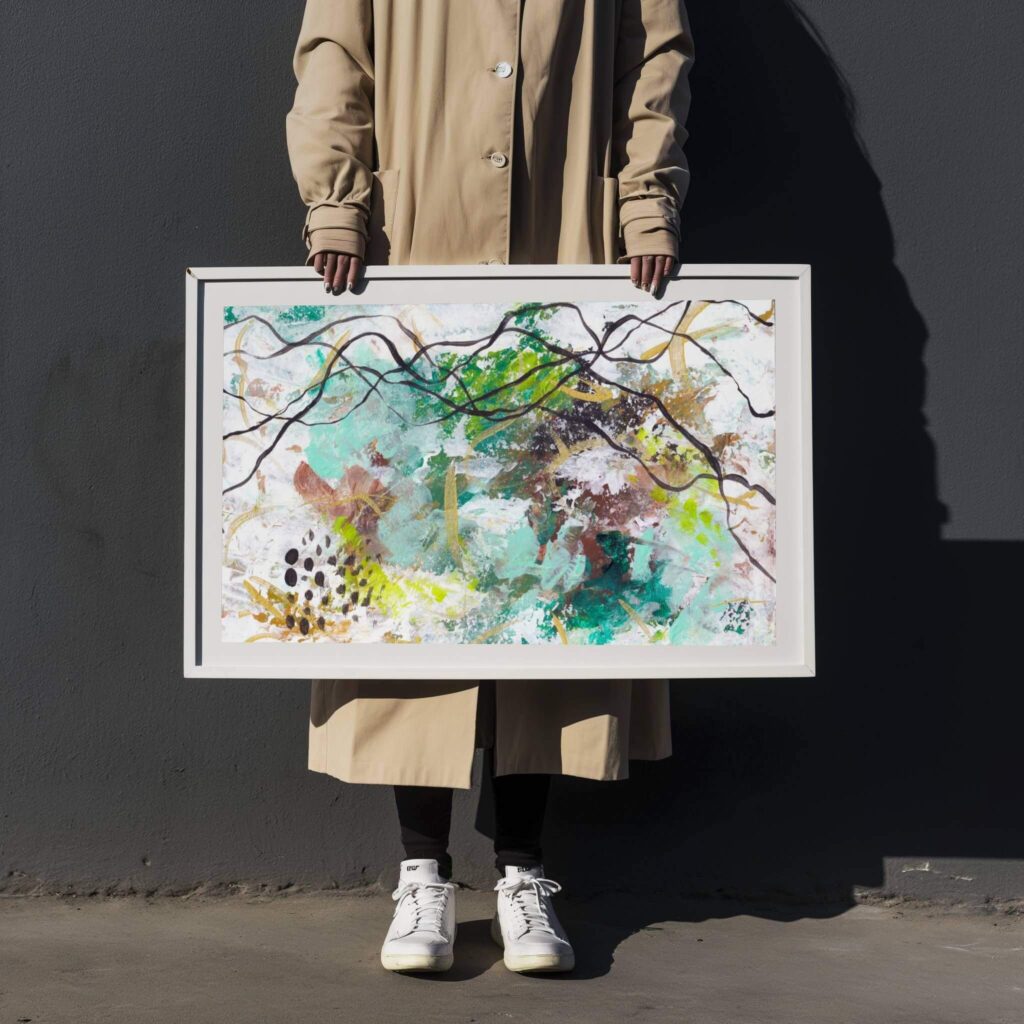
How to Choose Art for Mindful Office Spaces (Without Resorting to Trends)
If there’s one place companies routinely go wrong with workplace art, it’s in the selection process.
Most offices don’t choose art. They source it.
And when sourcing becomes the goal, rather than curating, emotional resonance is usually the first thing to disappear.
This is especially true when decisions are outsourced to design firms who prioritise aesthetics over atmosphere. You end up with a space that looks contemporary, minimal, or “on-brand,” but feels emotionally hollow. It ticks visual boxes but leaves people internally untethered. The walls might impress, but they don’t hold.
When you’re investing in art for mindful office spaces, the goal isn’t to decorate. It’s to support. It’s to anchor. It’s to reflect the emotional tone your team and your clients need in order to feel grounded, regulated, and ready to do meaningful work.
In this section, we’ll explore how to choose emotionally intelligent artwork with depth, purpose, and presence, without falling into the trap of seasonal design trends or sterile corporate clichés.
The First Rule: Choose for Feel, Not Theme
The most emotionally resonant office art is never chosen from a search for “office-appropriate prints.” It begins with the question: What emotional experience do we want people to have in this space?
Not what they should think.
Not what they should admire.
What they should feel, in their body, in their breath, in their nervous system.
That question changes everything.
A theme-based approach, say, “growth,” “innovation,” or “strength”, will typically lead you to literal imagery, visual metaphors, or word-based artwork that tries to force a feeling rather than invite one. This often backfires. Instead of creating space for presence, these pieces create performance pressure. They push a narrative, rather than holding space for emotion.
Emotionally intelligent art reverses that logic. It’s chosen not to say something specific, but to allow something truthful. That might mean abstraction. It might mean texture, silence, or softness. It might mean choosing a piece that feels like an exhale, not a statement.
That feeling becomes the emotional permission slip for the entire space.
Understand the Purpose of the Room
Every room has a functional purpose, but it also has an emotional one. That emotional function should guide the kind of art you place inside it.
Here’s how to approach a few key zones:
-
-
Boardrooms and decision rooms need art that grounds. Look for pieces that feel calm, structured, and open. These are high-pressure spaces. The art must steady the nervous system, not spike it.
-
Reception and entrance areas need art that regulates. You’re helping people transition from the outside world into your emotional world. Art here should feel welcoming, not overwhelming, stable, not sterile.
-
Executive offices require art that holds space. These rooms carry emotional weight, decision fatigue, and leadership pressure. Choose art that quietly supports complexity, nothing loud, ironic, or overly “clever.”
-
Wellness rooms or recovery zones benefit from art that restores. Look for soft colour palettes, gentle textures, and compositions that allow visual rhythm without clutter. These pieces should evoke breath, not brilliance.
-
Creative or strategy areas can accommodate more movement. Still, avoid art that shouts or agitates. You want energy without chaos, structure with play. Pieces that invite curiosity without creating distraction.
-
When each room is treated as its own emotional ecosystem, the art becomes part of the architecture of presence.
Ignore Trends. Trust Sensation.
One of the fastest ways to strip meaning from a workspace is to follow visual trends.
What’s fashionable this year, neon graffiti overlays, AI-generated collages, digital mandalas, might be forgettable next year. Worse, it might feel emotionally incoherent within weeks. These pieces often dominate attention, rather than quietly regulating it.
Emotionally intelligent businesses do not decorate based on Pinterest moodboards or seasonal art fairs. They choose work based on sensation. How does the piece make your body feel when you stand in front of it? Do your shoulders drop? Does your breath deepen? Do your thoughts slow down?
These are the metrics that matter when selecting art for mindful office spaces.
They’re not easy to quantify, but they are instantly felt. And that felt sense is what your team, your clients, and your nervous system will be responding to every single day.
Know the Difference Between Decorative and Resonant
Decorative art fills space. Resonant art creates space.
It may seem subtle, but the distinction is critical. Decorative work is typically chosen to match the interior design scheme, colour-matched, spatially balanced, and “clean.” But it rarely carries emotional weight. It doesn’t disrupt tension. It doesn’t offer psychological depth. It exists to be seen, not to be felt.
Resonant art, on the other hand, has emotional presence. It might not match your sofa, but it will match the human beings in the room.
It won’t shout. But it will stay.
That’s the kind of work that becomes part of your company’s emotional infrastructure, not just the furniture.
Look for Abstract, Not Ambiguous
There’s a common misconception that emotionally intelligent art is “ambiguous,” or vague. That’s not quite right.
The best work for mindful spaces is often abstract, meaning it’s non-literal, emotionally open, and visually spacious, but it’s not emotionally shapeless. Good abstract work has depth, structure, rhythm. It invites presence, not confusion.
Ambiguous art, by contrast, often lacks grounding. It may be conceptually interesting, but emotionally disorienting. In a workplace context, that creates the opposite of what you want: fragmentation.
To avoid this, look for work that has visual coherence. Even if it’s abstract, it should feel like it’s holding together. Like it’s offering something steady, even if that offering is hard to name.
Work With Artists Who Understand Emotional Context
Many commercial art vendors sell reproductions or licence-based works without any connection to emotional tone. This often leads to misalignment, where the piece looks appropriate but feels out of place.
By contrast, when you work directly with an artist who understands emotionally intelligent design, the process becomes a collaboration. You’re not just buying art. You’re co-creating an atmosphere. You’re bringing someone into your emotional vision for the space, and letting their work help shape it.
This is especially important in founder-led businesses, coaching practices, design studios, or therapeutic environments, where emotional coherence matters more than visual conformity.
Choose artists who ask questions, not just about colour palettes, but about what you want people to feel. Those are the artists who understand the deeper function of their work, and who will help you build something that lasts.
Avoid Corporate Clichés at All Costs
There is no faster way to strip presence from a room than to hang something that screams “corporate wall art.”
You know the kind:
-
-
Abstract cityscapes with motivational overlays
-
Word art that says “collaboration” in Helvetica Bold
-
Mountains with the word “focus” floating above the peak
-
These images might seem safe. But emotionally, they’re loud. They try to direct emotion instead of inviting it. They pressure the viewer into alignment, instead of meeting them where they are.
In mindful office spaces, that kind of manipulation doesn’t work. It creates emotional dissonance. It undermines trust. And it signals, intentionally or not, that emotional nuance is not welcome here.
Instead, choose pieces that hold ambiguity with grace. That don’t need to explain themselves. That trust the intelligence, and the emotions, of the people in the room.
Choose Fewer Pieces With More Weight
In emotionally intelligent design, more is not better. A few well-placed works, chosen with care and depth, will have a far greater impact than a wall full of filler.
Treat each piece as an emotional anchor, not a filler for an empty wall. Give it breathing room. Allow it to become part of the emotional rhythm of the space.
Think about line of sight. Where do people look when they exhale, when they think, when they pause? Those are the moments where art can serve as a co-regulator, a visual grounding point in a cognitively demanding day.
Overfilling a space with visual content will only dilute the impact. Instead, allow each piece to carry weight. Let it have presence. That restraint is what creates depth, and depth is what emotionally intelligent offices need most.
Let Function Guide Form
Ultimately, the art you choose should serve the function of the room, not distract from it. That doesn’t mean it needs to be literal. It means it needs to work with the emotional arc of the day.
In high-stakes spaces, choose pieces that regulate the nervous system. In transition spaces, use art to smooth energetic shifts. In quiet rooms, support inner clarity with visual spaciousness. In collaborative spaces, allow a gentle pulse of visual energy, but avoid overstimulation.
Treat every piece not as an accessory, but as a tool. A tool for clarity. A tool for coherence. A tool for presence.
When chosen with that in mind, art stops being something people walk past, and starts becoming something people return to.
Summary: Curation Is Culture
When you invest in art for mindful office spaces, you’re doing more than designing an environment. You’re creating a silent culture, one that speaks to emotional truth, inner steadiness, and the real conditions of deep work.
Forget what’s trending. Forget what the interior catalogues are selling this quarter. Forget what looks clever in a pitch deck.
Choose work that regulates. Choose work that rests. Choose work that brings people back to themselves.
Because when your walls offer real presence, your people don’t just perform better.
They feel better.
They stay longer.
And they build something that lasts.
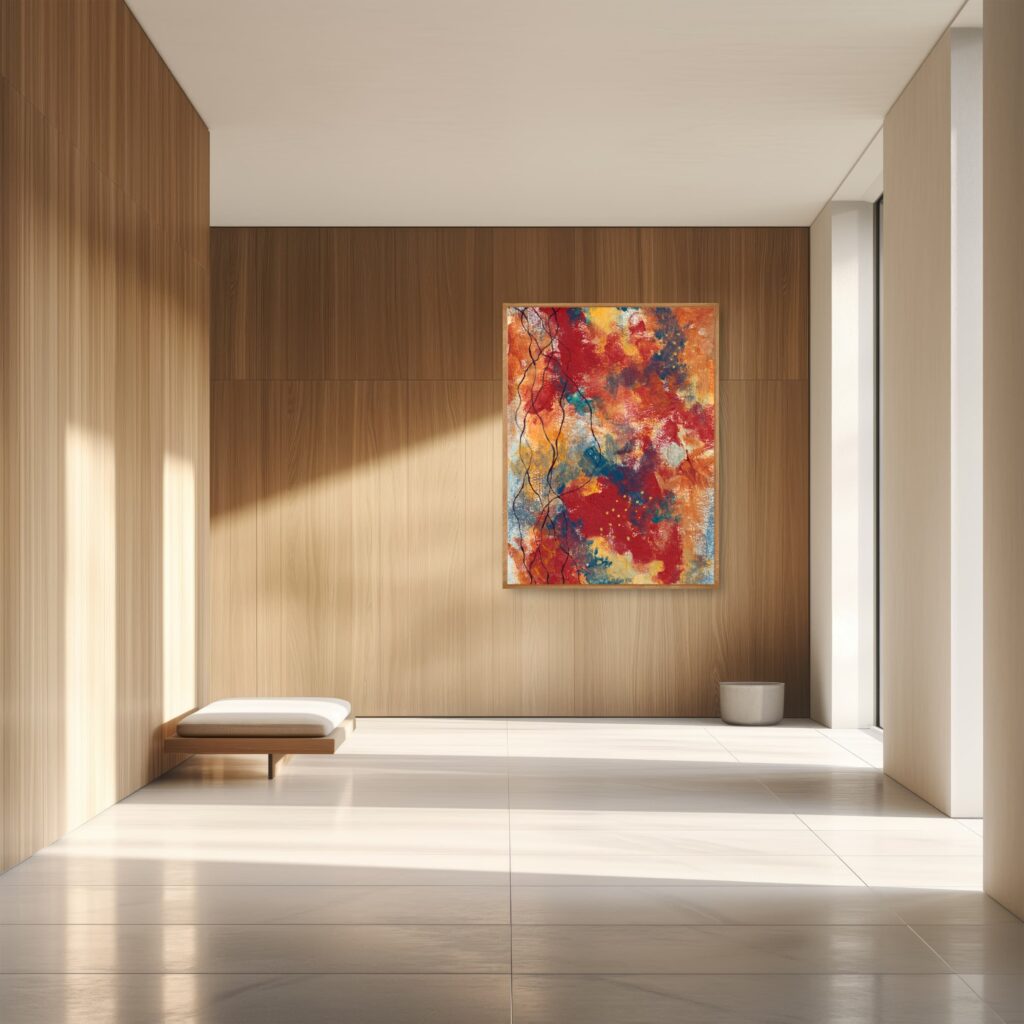
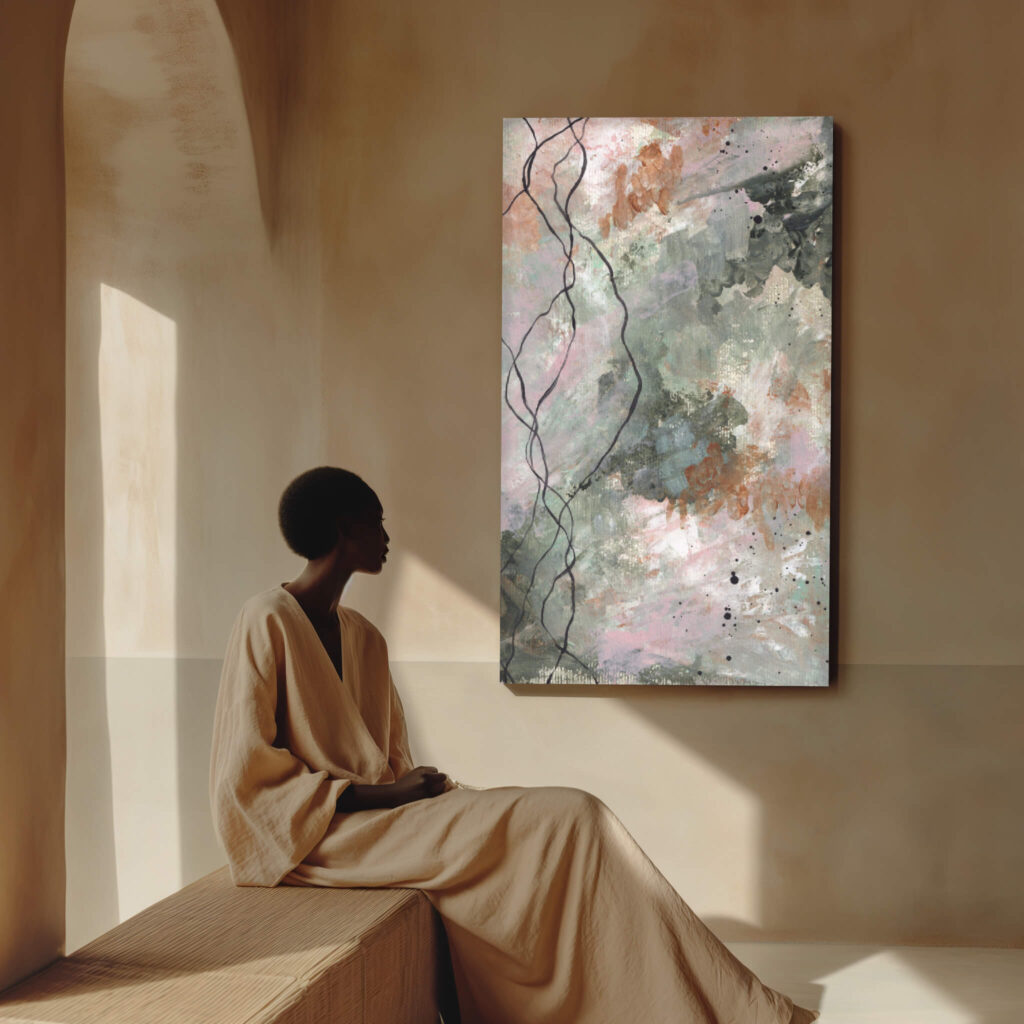
Where Most Workplace Art Installations Go Wrong
If you’ve ever walked into an office and immediately felt tension, even though everything looked “professionally designed”, you’ve already experienced this problem.
A lot of workplace art installations are technically polished, visually cohesive, and budget-justified. But emotionally? They fall flat. Or worse, they agitate. They overstate. They over-brand. They try too hard to inspire. And they end up doing the opposite.
They turn what could have been a healing, regulating space into a performance environment.
They create surfaces to look at, but no space to feel within.
When this happens across an entire office, floor by floor, meeting room by meeting room, it creates a cultural tone that’s hard to recover from. Even the best strategy, clearest communication, or strongest leadership will struggle to flourish in a space that constantly misfires at the emotional level.
In this section, we’ll unpack the most common mistakes businesses make when selecting and installing art for mindful office spaces. These aren’t just aesthetic errors, they’re emotional disconnects. And correcting them can change the entire internal atmosphere of your organisation.
Mistaking Visual Noise for Energy
It’s a common misconception that “creative” or “dynamic” workspaces should be filled with high-contrast imagery, loud colours, or concept-heavy installations.
Designers will often argue that bold visuals keep things lively, spark conversation, and energise teams.
But constant visual intensity does not support creative output, it disrupts it.
Especially in industries where deep focus, strategic thinking, or emotional intelligence are core to performance, this approach backfires fast.
When every wall is trying to say something clever or make a visual impact, the brain becomes overstimulated. The nervous system stays in low-level alert. Emotional bandwidth narrows. And eventually, employees learn to tune everything out, including the people around them.
Emotionally intelligent art isn’t about creating excitement. It’s about creating clarity. And clarity doesn’t come from shouting. It comes from coherence.
Over-curating for Aesthetics, Under-curating for Atmosphere
Some offices take the opposite approach, they go minimal. Every piece is clean, monochromatic, and curated to match the interior design palette. It’s all very sleek. Very Instagrammable. Very lifeless.
In these spaces, the art becomes part of the furniture, another surface to style, another colour block to balance. But it never becomes part of the emotional environment.
This kind of over-curation often stems from a fear of disrupting the design vision. And while visual cohesion is valuable, it should never come at the cost of emotional resonance.
When you choose art solely because it “fits the scheme,” you’re no longer selecting for human beings. You’re selecting for optics.
Art for mindful office spaces is not there to reinforce the room’s aesthetic. It’s there to create the room’s emotional tone. And if that tone is missing, no amount of symmetry will save the space.
Treating Art as an Afterthought
Many businesses spend months designing their layout, sourcing furniture, and planning logistics, then scramble to install art at the last minute to “finish” the space.
This often leads to hasty decisions, poor placements, or low-quality prints that fail to deliver any emotional value. The artwork becomes a visual filler, rather than a psychological anchor.
Worse still, art that’s added at the end of a build is often positioned in leftover spaces, corridors, forgotten corners, above cabinets, instead of being strategically placed where the nervous system needs support.
The best environments treat art as part of the spatial plan from day one.
Where will people pause?
Where will they feel overloaded?
Where will they be reflecting, recovering, or preparing for high-stakes work?
Those are the moments where artwork should live. Not as a finishing touch, but as an emotional companion to the function of the room.
Equating Motivation With Regulation
One of the most widespread missteps in workplace art is the use of motivational messaging. Words like “Focus,” “Hustle,” “Success,” or “Teamwork” layered over images of mountains, athletes, or cityscapes.
This kind of art doesn’t inspire. It pressures. It implies that your value is in your output. That your inner life isn’t welcome here. That your primary function is to produce, and your environment exists to remind you of that constantly.
These messages don’t regulate the nervous system. They agitate it. And over time, the subtle psychological toll becomes evident, in burnout rates, conflict levels, and emotional disengagement.
Emotionally intelligent offices understand that regulation outperforms motivation every time.
When people feel calm, grounded, and emotionally spacious, they naturally move toward clarity, focus, and contribution.
When they feel watched, pushed, or judged, even by a poster, they start protecting themselves.
And protection is the enemy of presence.
Using Branding as a Substitute for Presence
There’s a trend in many corporate environments to use artwork as an extension of brand identity. The company colours appear in every room. The mission statement is turned into wall typography. The logo is abstracted into a mural. It’s all very coherent, and very hollow.
While brand consistency has its place, art is not the space to reinforce your authority. It’s the space to restore your humanity.
When clients, team members, or partners enter your workspace, they already know who you are. What they don’t know, and what they want to feel, is who you are emotionally. What it feels like to be in your world.
Brand-based art flattens that experience. It creates a feedback loop of corporate self-reference that feels emotionally thin.
By contrast, emotionally intelligent art offers something different. It provides quiet, textural, somatic information, a felt sense of presence that has nothing to do with positioning and everything to do with reality.
This isn’t about avoiding brand cues entirely. It’s about not letting them dominate the emotional space.
Installing for Visibility Instead of Function
Another mistake is installing artwork for maximum visibility, the wall people see when they walk in, the backdrop behind a Zoom screen, or the corridor where guests pass through.
While visibility has its purpose, the most powerful placement decisions are based on function, not optics.
-
-
Where do people experience emotional strain?
-
Where do decision-makers need clarity?
-
Where do clients need regulation?
-
Where does the day feel heavy?
-
Install artwork where it will support the nervous system, not where it will look good in a photo.
An emotionally intelligent piece quietly anchoring a strategy room will have more long-term impact than the biggest canvas in your reception if no one feels it.
Installing Too Much, Too Close, Too Loud
More art doesn’t mean more impact. In fact, overfilling a workspace with visual stimuli, especially if the pieces are large, high-contrast, or emotionally intense, creates fatigue.
Employees tune it out. Clients feel subtly overwhelmed. Focus disappears.
Likewise, placing artwork too close together, with no negative space or pause between pieces, turns your walls into a visual checklist, not a sequence of meaningful moments.
Emotionally intelligent art needs air. It needs space to resonate. It needs to be part of the rhythm of the room, not competing with it.
When in doubt, choose less, but better.
One well-placed, emotionally aligned piece will outperform an entire gallery wall of visual noise.
Treating Every Room the Same
Not every space in your workplace serves the same emotional function. A shared lounge, a founder’s office, a coaching room, and a boardroom all require different levels of emotional presence.
Yet in many offices, the same design principles are applied across all zones. Similar artworks. Similar placements. Similar tones.
This uniformity might seem coherent, but emotionally, it creates confusion.
Each room should have its own emotional identity, not just visual style, but nervous system function.
-
-
Where is restoration needed?
-
Where is focus essential?
-
Where is co-regulation required?
-
Where should stillness lead?
-
Art selection should reflect that nuance, or else the space becomes emotionally flat, even if it looks visually impressive.
Outsourcing Emotion to the Designer
In projects where interior design teams have full authority, art decisions are often made for visual balance, budget, and sourcing ease. Emotional intelligence is rarely part of the brief, unless the client insists on it.
If your goal is to create a mindful office space, you can’t afford to hand over the emotional tone of your environment to someone who doesn’t live in it.
This doesn’t mean doing everything yourself. It means working collaboratively. Sharing the emotional goals of each space. Communicating what your team actually needs to feel. And insisting that emotional resonance matters more than aesthetic perfection.
If your designer doesn’t understand that, or if your procurement team doesn’t know how to source for presence instead of price, it’s time to get new collaborators.
The nervous systems in your office deserve better.
Summary: Most Mistakes Are Made Before the Art Arrives
Poor workplace art is not a materials issue. It’s an emotional clarity issue.
It happens when no one stops to ask:
-
-
What does this space need to hold?
-
What do our people need to feel?
-
Where do we need visual silence?
-
What will help us regulate, not impress?
-
These questions are simple, but powerful.
And when you build your installation strategy around the answers, you won’t just avoid mistakes, you’ll create a workplace that feels emotionally alive.
That’s what your team wants.
That’s what your clients will remember.
And that’s what will carry your culture through more than any deck or initiative ever could.
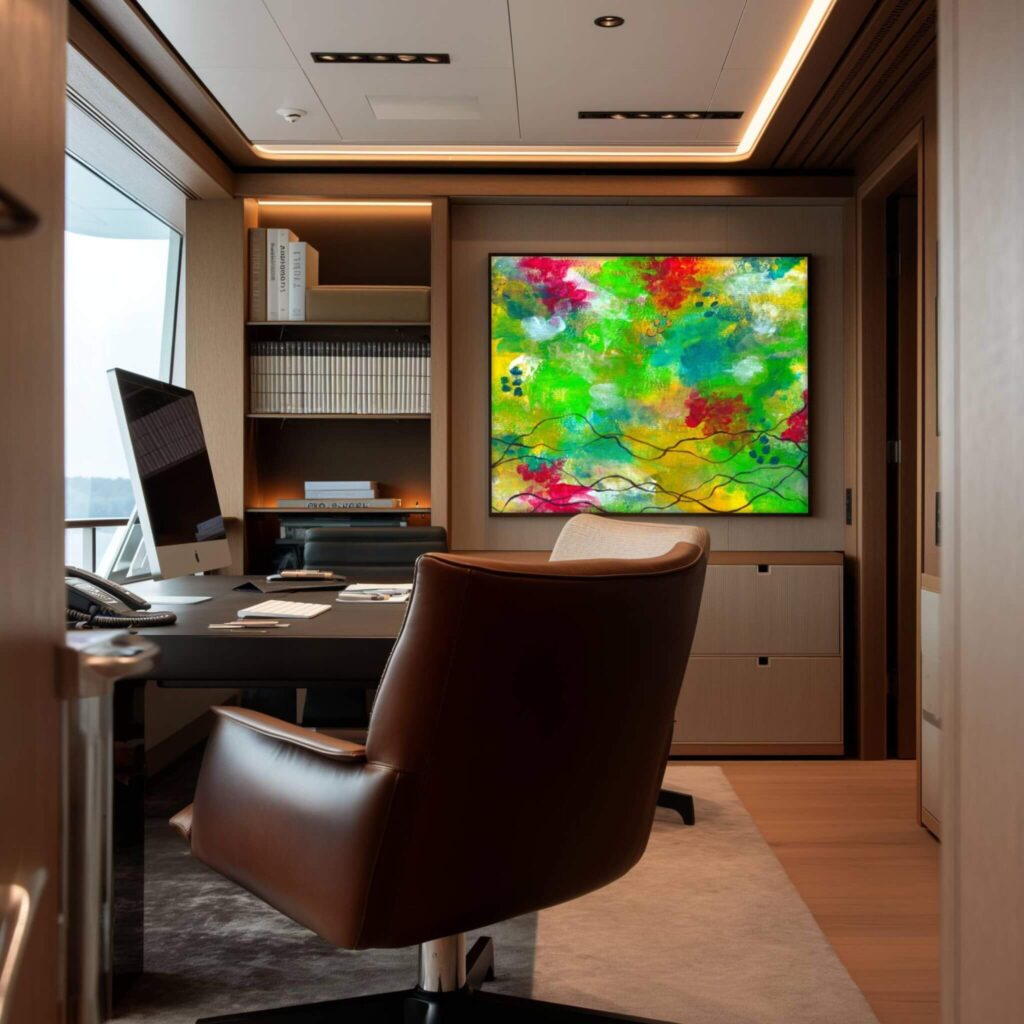
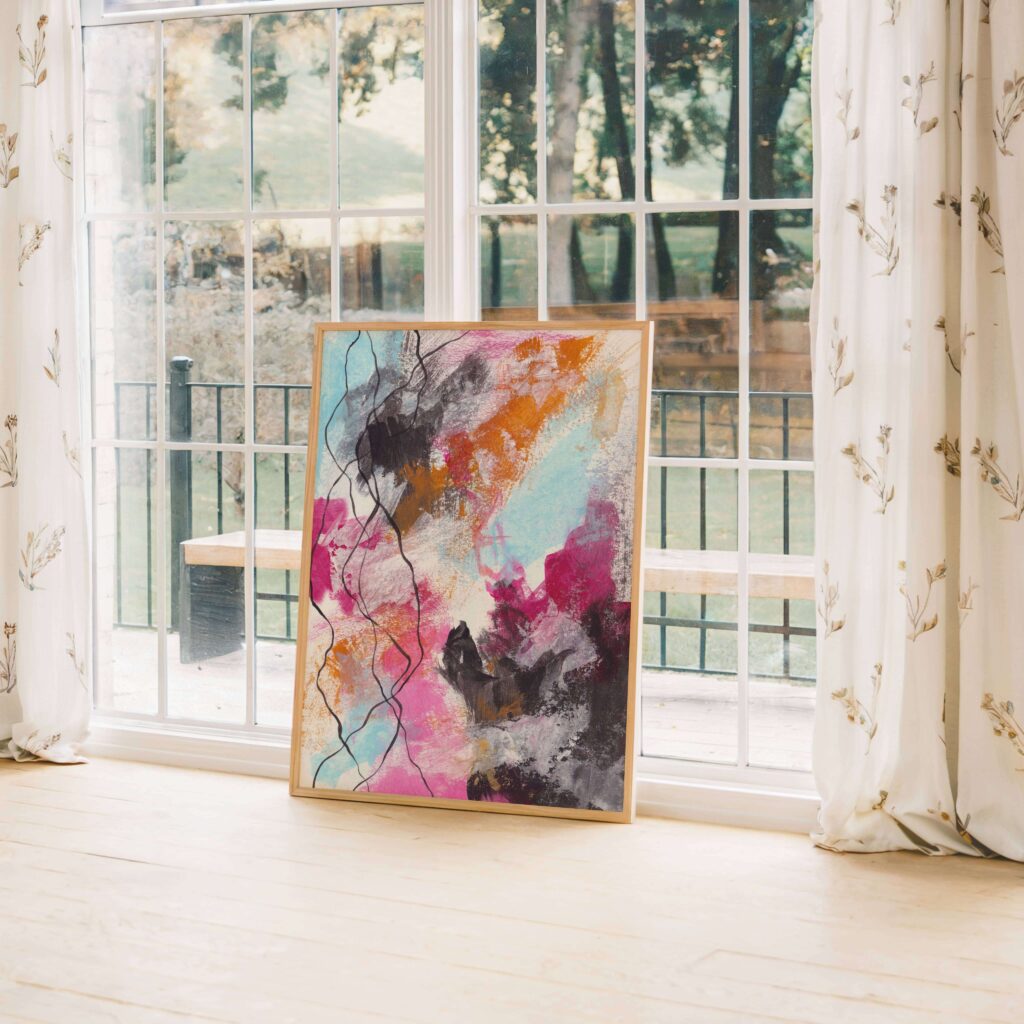
Case Study: The Value of Capsule Commission in High-End Workspaces
Not every office needs more art. But some spaces do need something, and what they need isn’t louder branding or a better-framed print. They need something quieter. Something that meets the weight of the room without pushing against it.
That’s what Capsule Commission was created for.
It wasn’t designed to fill walls or complete an aesthetic. It exists for moments that can’t quite be named, but still live in the room. Pressure that isn’t visible, but is always present. The shift between two decisions. The breath between meetings. The unspoken weight of leadership or emotional labour that doesn’t get acknowledged but still builds up across the week.
In high-functioning offices, especially those shaped by emotionally intelligent leadership, these moments happen constantly. The space holds a lot, even when the work isn’t visible. Capsule Commission isn’t there to make a statement. It’s there to hold one of those moments. Privately. Intimately. Without performance.
What It Actually Is
Capsule Commission is a private offer. It includes one A2 gallery-grade canvas print, created after a written consultation. No call. No brand brief. Just a quiet emotional reflection form, and the space to respond honestly, if you’re ready to.
Once you send it back, I create a single painting in the studio. It’s built from what you shared, and also from what sits just underneath it. The painting is digitised and printed on canvas. It isn’t part of a series, and it won’t be shown elsewhere. It’s made for you, and it stays that way.
Most commissions are ready in 4 to 5 weeks. They’re delivered stretched and ready to hang. You’ll receive optional guidance if you want help deciding where to place it or how to frame it, but most people know, once they see it, exactly where it belongs.
Why It Works in Office Spaces
In a lot of executive or leadership spaces, people are holding more than they’re saying. Decision fatigue. Client tension. Emotional containment. Even when the room looks right, something often feels tight. You can sense when a space hasn’t made room for stillness. The air feels different. The pace never really softens. You finish the day and it’s like the space is still vibrating.
One Capsule Commission, in the right spot, changes that completely.
It doesn’t demand attention. Most people don’t even notice it consciously at first. But they feel different when they’re in the room. Meetings settle faster. The space becomes somewhere people can think. Conversations soften. You feel more like yourself, not because the canvas is “so powerful,” but because it isn’t trying to be anything.
It doesn’t explain. It doesn’t decorate. It just steadies the atmosphere, without interfering.
It’s Not for Everyone
If you’re looking for a statement piece, this isn’t it.
If you’re decorating a boardroom and just want something that “looks nice,” this probably isn’t right either.
Capsule Commission is for people who are already building spaces that carry emotional weight, and who want that weight to be held, not ignored.
That might be a founder’s office. A therapeutic meeting room. A quiet transition space. A room where clients walk in carrying a lot. Or a space where you, privately, feel like you’re holding too much of it all, all the time.
This commission doesn’t fix that. It doesn’t give you clarity or offer a breakthrough. But it does meet you in that space, quietly. And that changes things.
The Details
-
-
Format: A2 (about 42 x 59.4 cm), gallery-grade canvas print
-
What’s included: Private written reflection form, emotional interpretation, creation, digital processing, printing, stretching, and delivery
-
Timeline: Around 4–5 weeks
-
Cost: £2,500
-
Deposit: £500 non-refundable deposit to confirm your place
-
Edition: One of one. No copies. No public archive. This piece is for you only.
-
There’s no back-and-forth, no edits, and no input beyond the written form. The work unfolds from there.
This is not a co-designed product. It’s a private presence, created from what you shared.
Where It Belongs
Most commissions end up in personal offices, places where reflection already happens, or where people want to start making more room for it.
Some live in reception areas where clients need something to rest into before stepping into conversation. Others have been placed in coaching studios, leadership consulting spaces, or therapy rooms where words are already doing a lot of the work, and the space needs something that holds quietly, without adding more.
This isn’t a piece that starts conversations. It’s usually the one thing that doesn’t need to be talked about.
And that’s exactly why it works.
What People Notice
People don’t usually comment on the painting itself. But they sit differently. They pause longer. They say things like, “This room feels better now,” or “I don’t know what it is, but it’s easier to think here.”
That’s the kind of shift this is made for. It’s not for show. It’s not a visual highlight. It’s a quiet point of presence in a space that already holds a lot. And when the rest of the office is full of movement, noise, pressure, or pace, having one still, grounded thing, one point of return, can change the entire tone of the day.
When You Know It’s Time
You’ll know.
Usually it’s not about the wall.
It’s about you.
About what the space is carrying, and whether it has anything in it that can carry you back.
If you’ve been thinking about making your space feel different, not better, not newer, just more grounded, this is a quiet place to begin.
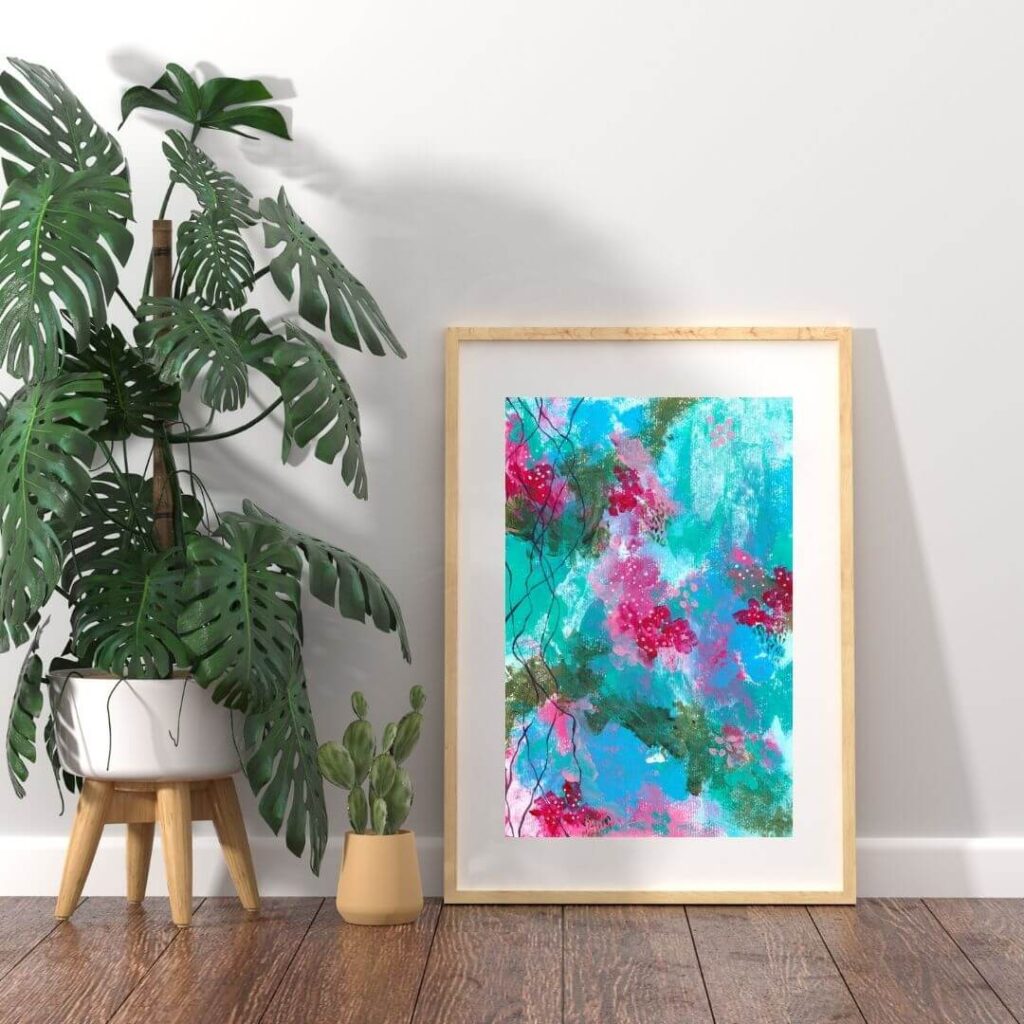
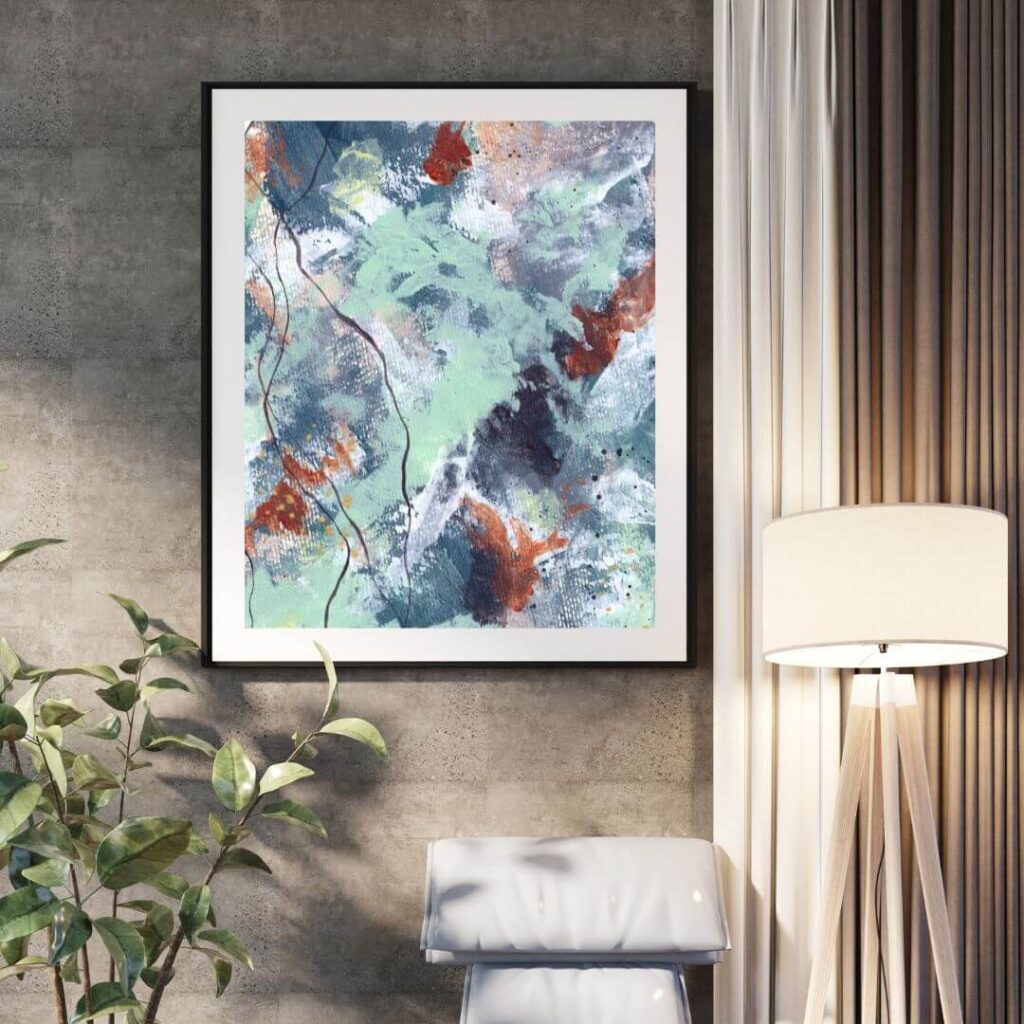
The Vault: A Curated Catalogue for Emotionally Intelligent Office Art
Not everyone needs a commission.
Sometimes, what’s needed is already here, just not visible until the right moment.
That’s what the Vault was built for. It’s not a storefront. It’s not a rotating collection. It’s not even visible unless you’re invited in.
The Vault is a quiet, private catalogue of selected works that already exist, each one chosen for the kind of space where emotional weight is present, but rarely named. Offices where the pace is high but the intention is deep. Rooms that ask for calm, not energy. Spaces that don’t need more art, but do need something steady to hold the atmosphere.
These pieces weren’t made for mass appeal. They weren’t created to match an aesthetic. They were made in the studio during periods of deep presence, then selected carefully for their ability to support mindful spaces with emotional integrity.
The Vault isn’t large, but it doesn’t need to be. Each piece is there because it belongs, not because it fills space.
What the Vault Actually Is
The Vault is a private catalogue of emotionally intelligent works available as gallery-quality canvas prints. They are hand-selected from the studio archive, not licensed designs or décor pieces. Each work has been chosen for its tone, stillness, and emotional depth the kind that supports real focus, real presence, and real recovery.
All works in the Collector’s Vault are available as ready-to-hang canvas prints. They are printed to order, professionally stretched, and delivered directly to the client. Most are best suited to spaces that need presence, not performance.
You won’t find anything here that’s trying to impress.
Who It’s For
The Collector’s Vault exists for people who already know what kind of emotional tone they want in their workspace. They might not have the capacity, timeline, or desire to commission a piece from scratch, but they know that choosing the right artwork isn’t about matching their sofa or filling a gap in the wall.
It’s for:
-
-
Founders building quiet, thoughtful environments that support decision-making and restoration
-
Therapists, coaches, and consultants who hold a lot in their spaces and want the walls to do some of that holding too
-
Designers sourcing meaningful, regulation-based art for leadership suites, wellness rooms, or emotionally intelligent hospitality spaces
-
Teams building office environments where trust, focus, and real presence matter more than aesthetics
-
These aren’t spaces that need high-concept design. They need something calm, steady, and felt.
What Makes These Pieces Different
These works weren’t made for a catalogue, a trend, or a decorative purpose. The Collector’s Vault holds approximately 30 pieces from my studio archive, each created across different seasons of the practice, not as part of a unified series, but as honest, standalone works.
Some carry stillness. Others hold energy, complexity, or contradiction. What they all share is depth. Not because they were born from a single emotional state, but because they weren’t made to please or perform. They weren’t made to match interiors or to sell quickly. They were made because they needed to be made, and only now, later, have they been gathered.
That’s what makes them different.
They weren’t rushed or outsourced or designed to be neutral. They are genuine, resolved artworks that don’t need to justify their place in a room, but will change the atmosphere when they’re there.
For mindful office spaces, this kind of presence matters. You’re not just choosing something to look at. You’re choosing what the room holds — and how it holds you back.
Format, Pricing, and Access
The Vault includes canvas prints priced between £1,500 and £8,000, depending on scale, texture, and original format. All works are printed on gallery-quality canvas, stretched professionally, and delivered ready to hang. Some are available in multiple sizes. Others only exist in a single large format.
There is no public listing, no online store, and no buy-now button.
The Collector’s Vault is accessed by private request only. This allows each work to be placed thoughtfully, into homes, offices, or wellness environments where emotional resonance matters more than convenience.
Framing guidance is available if needed. Delivery is global.
These pieces are not editioned or released as collections. They are individual works from a professional archive, quietly made available, one at a time.
How These Pieces Work Inside a Space
Clients who’ve placed Collector’s Vault works in their office don’t always describe what they feel. They just mention that the room feels better. That conversations are slower. That something about the energy of the space softened.
These are not centrepieces. They’re not attention-seekers. Most of the time, they’re just there, quietly regulating the room while everything else keeps moving.
One piece in a founder’s office. One above a therapy chair. One across from the client couch. One in a private corner where you go between meetings just to breathe for a minute before re-entering the noise.
That’s where they belong.
You Don’t Need to Justify It
You don’t have to explain why you want a space to feel better. Or why you’d rather work in an environment that gives something back instead of just holding your productivity.
You don’t need to create a pitch for art that supports presence.
If you feel it, you already know.
And if the idea of choosing something that was made from stillness, something that doesn’t push, doesn’t shout, and doesn’t pretend to be more than it is, resonates with you, then the Collector’s Vault is open.
Not for everyone. But maybe for you.
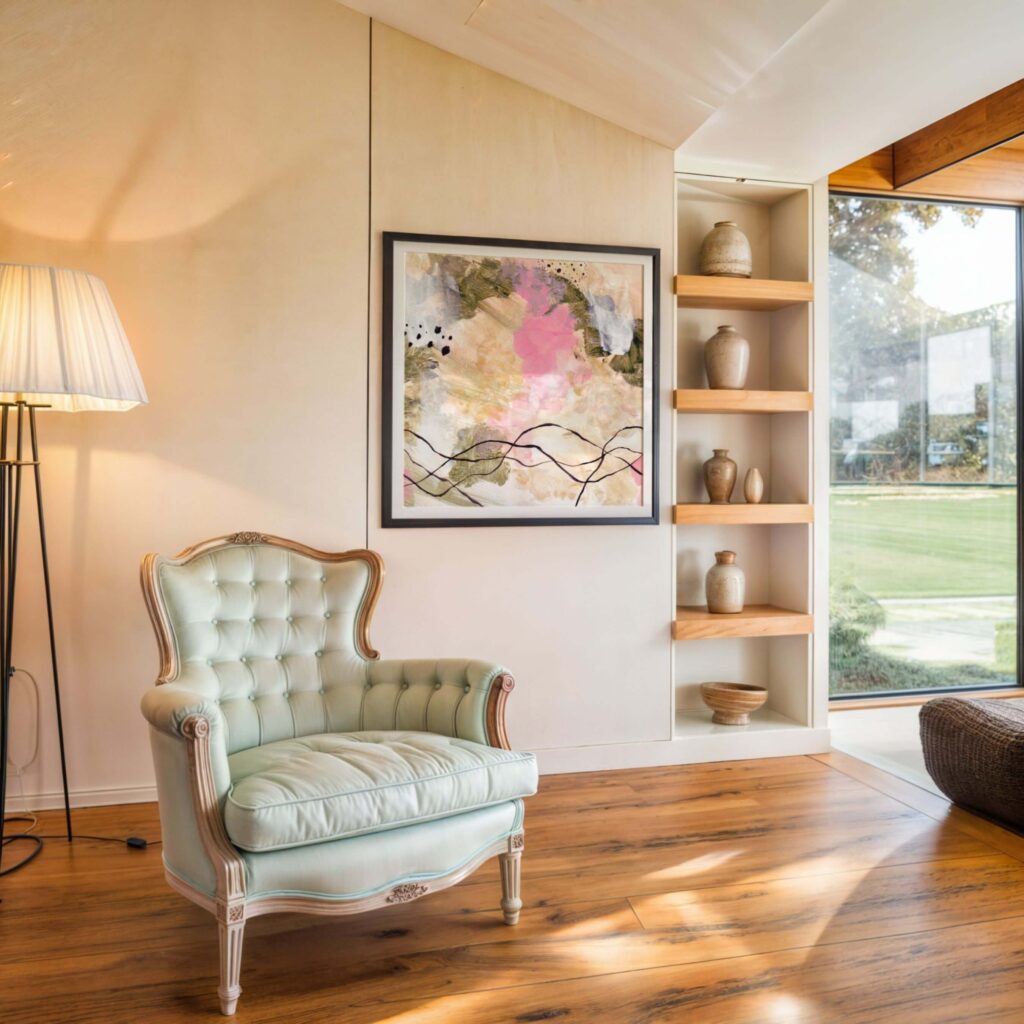
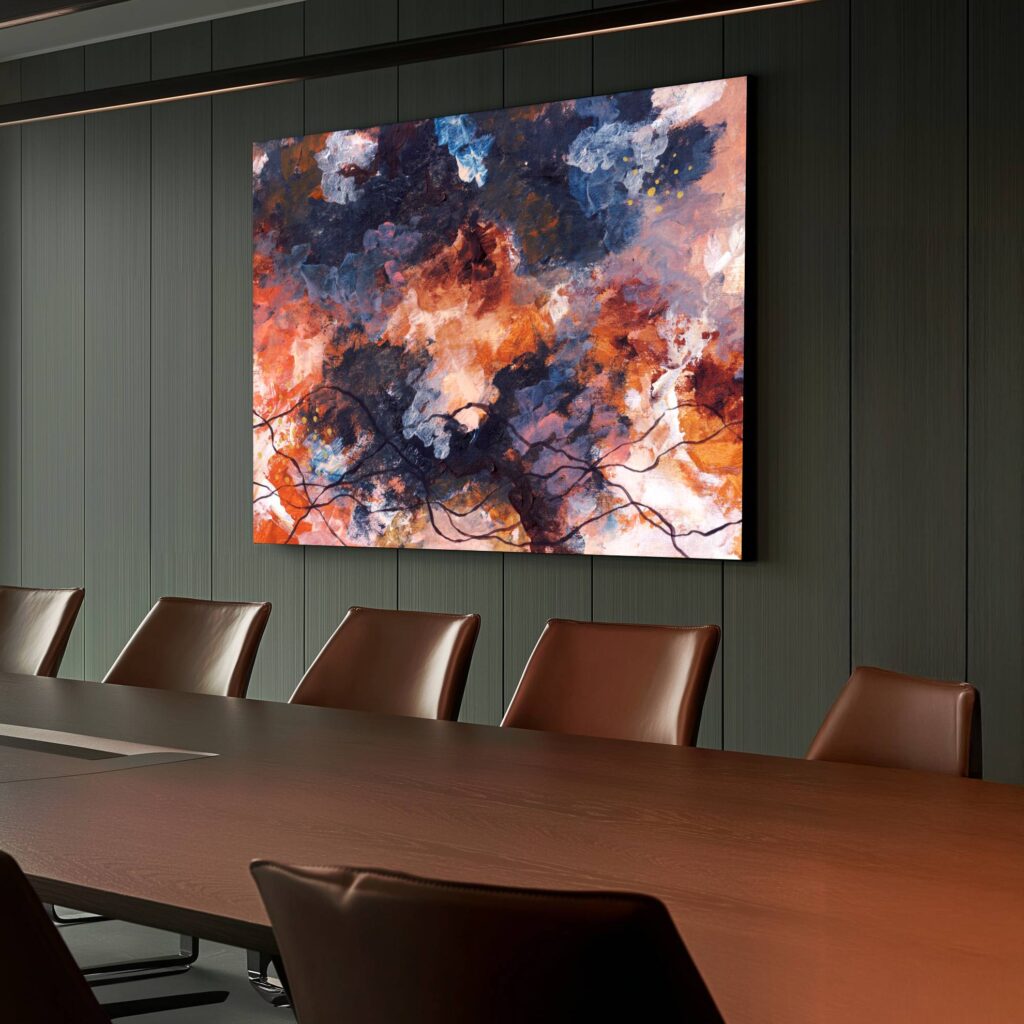
Installation, Placement, and the Psychology of Space
Even the most resonant artwork can lose its power when placed without care. Just like poorly designed lighting can flatten a room, a piece of art hung too high, too low, or in the wrong kind of emotional space can distort the very presence it was meant to bring.
In mindful office spaces, installation is not a finishing touch. It’s part of the experience design.
This isn’t about aesthetic harmony or creating the perfect Pinterest shot. It’s about emotional utility, how the artwork interacts with the nervous system, the purpose of the room, and the people moving through it. Especially when the work carries weight, stillness, or emotional charge, where it lives in the room can either support presence, or quietly disrupt it.
Think Like a Spatial Psychologist
Before reaching for the tape measure, ask this:
What does this space need to hold?
A boardroom where conflict resolution happens?
A founder’s office where complex decisions are made?
A treatment space where clients speak hard truths?
A rest space where burnout needs to soften before it shows up as turnover?
Each function carries its own energetic demand, and that informs what kind of piece belongs there, what tone it should hold, and how it should be placed.
Mindful office design requires thinking beyond surface impact. You’re not decorating a room. You’re shaping how people feel in it.
Placement Isn’t Decoration. It’s Direction.
People read a room the moment they enter it. Even before they look at you, they’ve registered where the light hits, whether there’s too much movement in the space, and what the room tells them about how to behave. Art contributes to that emotional architecture.
Placed with intention, art can say:
You are allowed to breathe here
You do not have to perform here
This is a space that understands depth and doesn’t need to explain it
In emotionally intelligent workspaces, that kind of message is gold.
It’s the difference between a space that just looks polished, and one that quietly regulates.
Common Placement Mistakes in Mindful Offices
Even the most thoughtful clients occasionally fall into these traps:
Centering artwork on a wall instead of in the visual field of seated clients or staff
The wall may be symmetrical. The humans aren’t.Placing emotionally charged pieces in high-traffic areas
Stillness doesn’t work when people are rushing past it.Matching colour palettes but ignoring emotional tone
Just because a piece shares a hue with your sofa doesn’t mean it shares your values.Choosing oversized art to signal prestige
Oversized doesn’t always equal powerful. Sometimes, it’s just loud.
Presence doesn’t shout. It hums. And if you hang a piece that hums in a space that demands shouting, the whole room will feel off.
Matching Energy, Not Aesthetic
Every piece in the Collector’s Vault or through Capsule Commission carries its own atmosphere. Some lean into groundedness. Others carry tension. A few allow for gentle dissolution. The question is not “what looks good here?” but “what energy needs support here?”
A high-focus workspace may benefit from clear, linear compositions that guide attention
A room for emotional processing might suit soft, layered work that invites deeper breath
A strategy suite might call for a piece that anchors, but doesn’t provoke
You’re not just matching visuals. You’re matching nervous systems.
Let the Art Hold Space, Not Dominate It
In mindful office design, art shouldn’t be a centrepiece. It should be a presence, felt, not forced. The goal is not to impress clients but to support the kind of interactions that happen in that room.
If it’s a one-on-one space, place the piece within the client’s sightline, not your own.
If it’s a shared workspace, make sure the tone of the piece supports the baseline nervous system, not your personal taste.
If it’s an executive space, avoid placing emotionally intense work directly behind your desk, otherwise, it competes with your own leadership presence.
The best feedback from art in office spaces is no feedback at all. Just… stillness. A room that holds better conversations. Quieter tension. Longer eye contact. Less rush to speak.
Placement Scenarios That Support Emotionally Intelligent Work
While every office is different, and each piece from the Vault or a Capsule Commission is unique, here are illustrative scenarios to show how emotionally intelligent art can be integrated into mindful workspace design. These are not case studies, just examples of how placement can shape presence:
In a private 1:1 consulting room, a mid-size vertical canvas might be placed directly across from the client seating area, offering emotional grounding without distraction. The visual complexity gives the mind something to rest on without pushing interpretation.
In a leadership retreat or executive reset room, a large-scale work could be placed in a side-view position, not the first thing guests see, but a presence that enters their awareness slowly, supporting softening and deeper breath once seated.
In a founder’s office or high-focus executive space, a subtle abstract piece might live on a side wall, not visible while working, but visible during reflection or meetings, subtly shifting the emotional temperature of difficult conversations.
In each of these examples, the placement isn’t decorative. It’s directional. Not to impress or distract, but to support deeper presence and emotional regulation in the room.
That’s the power of emotionally intelligent art. When placed well, it doesn’t just hang, it holds.
Framing, Lighting, and Longevity
Art for mindful office spaces doesn’t demand ornate framing or spotlight-level lighting. But it does require clarity:
Use a float frame or minimal profile to honour the integrity of the canvas without overpowering it
Lighting should be soft, diffused, and consistent, not directional or dramatic
Avoid glare-heavy positions near windows or reflective surfaces
The work should feel embedded in the room, not staged. And it should age well. Pieces from the Collector’s Vault or Capsule Commission are made to last and so is the tone they set.
Let the Room Breathe
Finally, resist the urge to fill every wall. Negative space matters. Stillness lives in the in-between.
If the room is already overstimulated, adding a piece of art, even a mindful one, won’t help. But if you create one intentional visual anchor, and let it breathe… that’s when it starts to work.
Presence doesn’t come from adding more. It comes from subtracting everything that doesn’t belong.

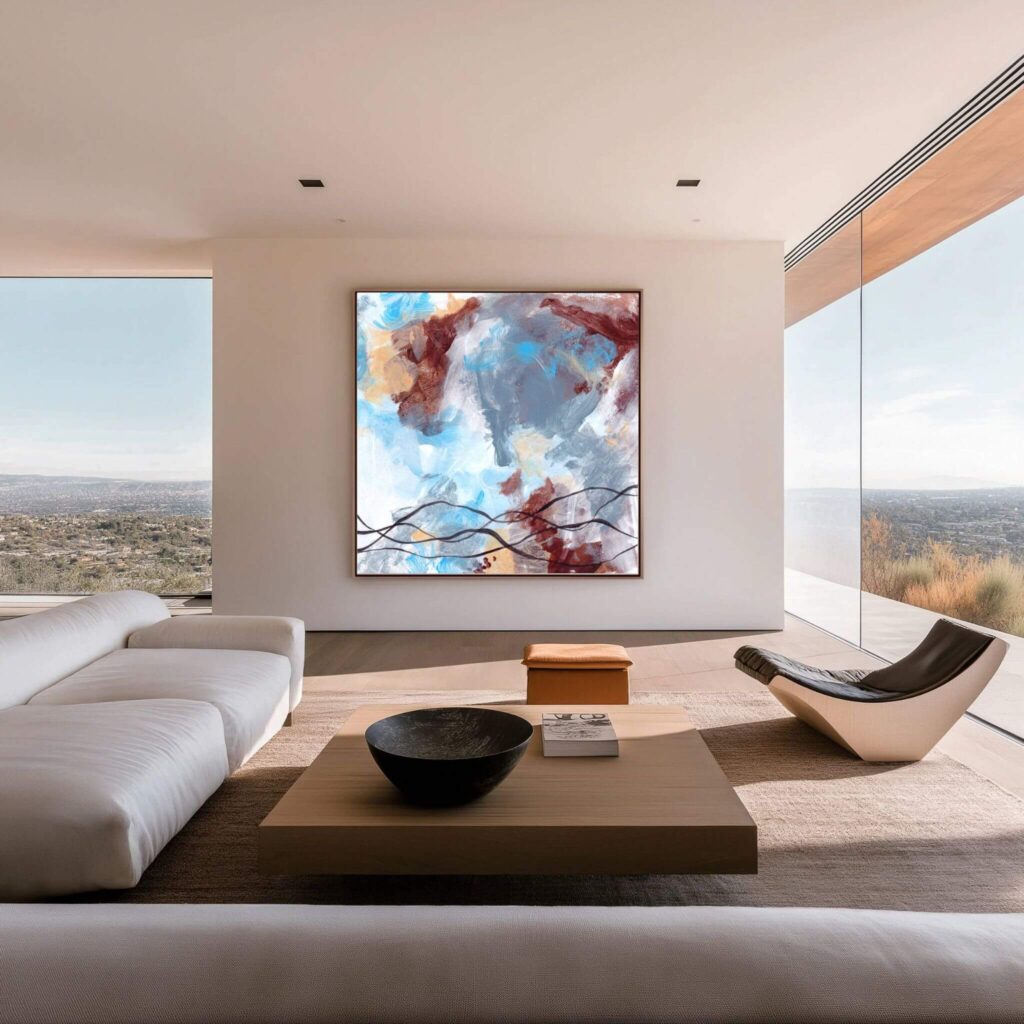
Conclusion; Rebuilding Atmosphere, Not Just Aesthetic
Let’s be honest. Most corporate art is soulless. It’s chosen to blend, not to hold. To look expensive, not to feel meaningful. To match the brand palette, not the people who sit in the room every day trying to hold things together.
That kind of art might not offend, but it doesn’t support. It doesn’t stabilise. It doesn’t soften the nervous system or create any kind of real return, emotional or otherwise.
But emotionally intelligent art does.
It changes the atmosphere without demanding attention.
It regulates the room before the first words are spoken.
It reminds people, even without language, that depth is safe here.
This is not a luxury. It’s the missing layer in most mindful office design.
When you begin with stillness, not trend, not style, not speed, the work you bring into the space carries a different kind of weight. It doesn’t push people. It holds them. It doesn’t show off. It shows up. And when it’s integrated intentionally, it becomes part of the emotional infrastructure of the workplace.
For founders building emotionally sustainable companies…
For therapists creating rooms that can hold trauma and truth…
For retreat leaders, designers, coaches, or visionaries…
Presence isn’t something you say.
It’s something you build, and let people feel.
Capsule Commission & Vault: Start Here
If you’re ready to bring that kind of atmosphere into your workspace, there are two ways to begin:
Capsule Commission
A private commission made in stillness, after a written emotional consultation. One canvas. One piece. One real, personal presence.
The Collector's Vault
A curated catalogue of 30 available canvas works drawn from my archive. Each one is made to order, not editioned, and not available via online shop.
These aren’t just objects. They’re presence made physical, built to live quietly, honestly, and intelligently in the spaces that matter most.
And that’s the real ROI:
Not louder design.
Not trendier rooms.
But a space that holds people the way you actually want to be held.

